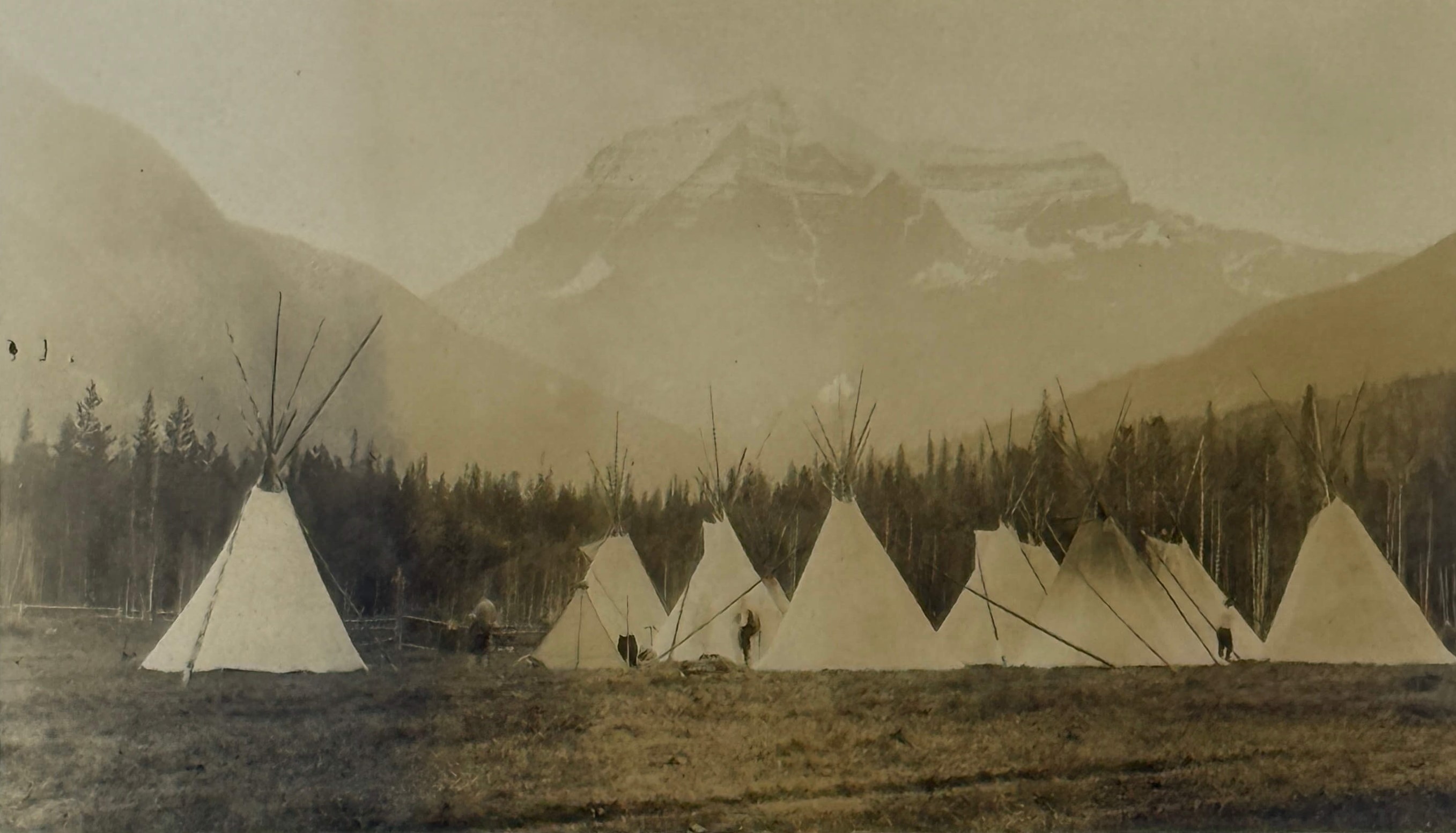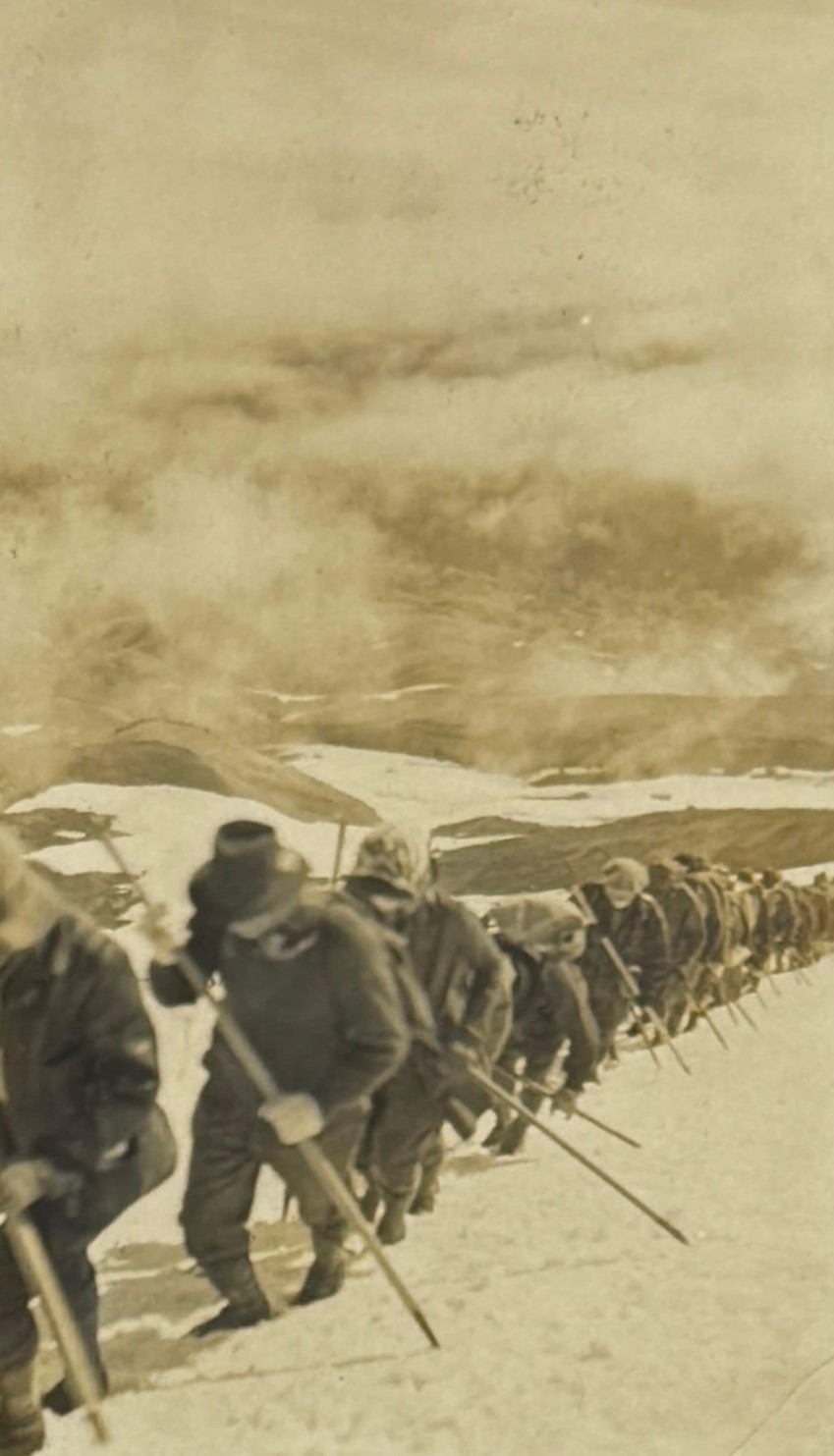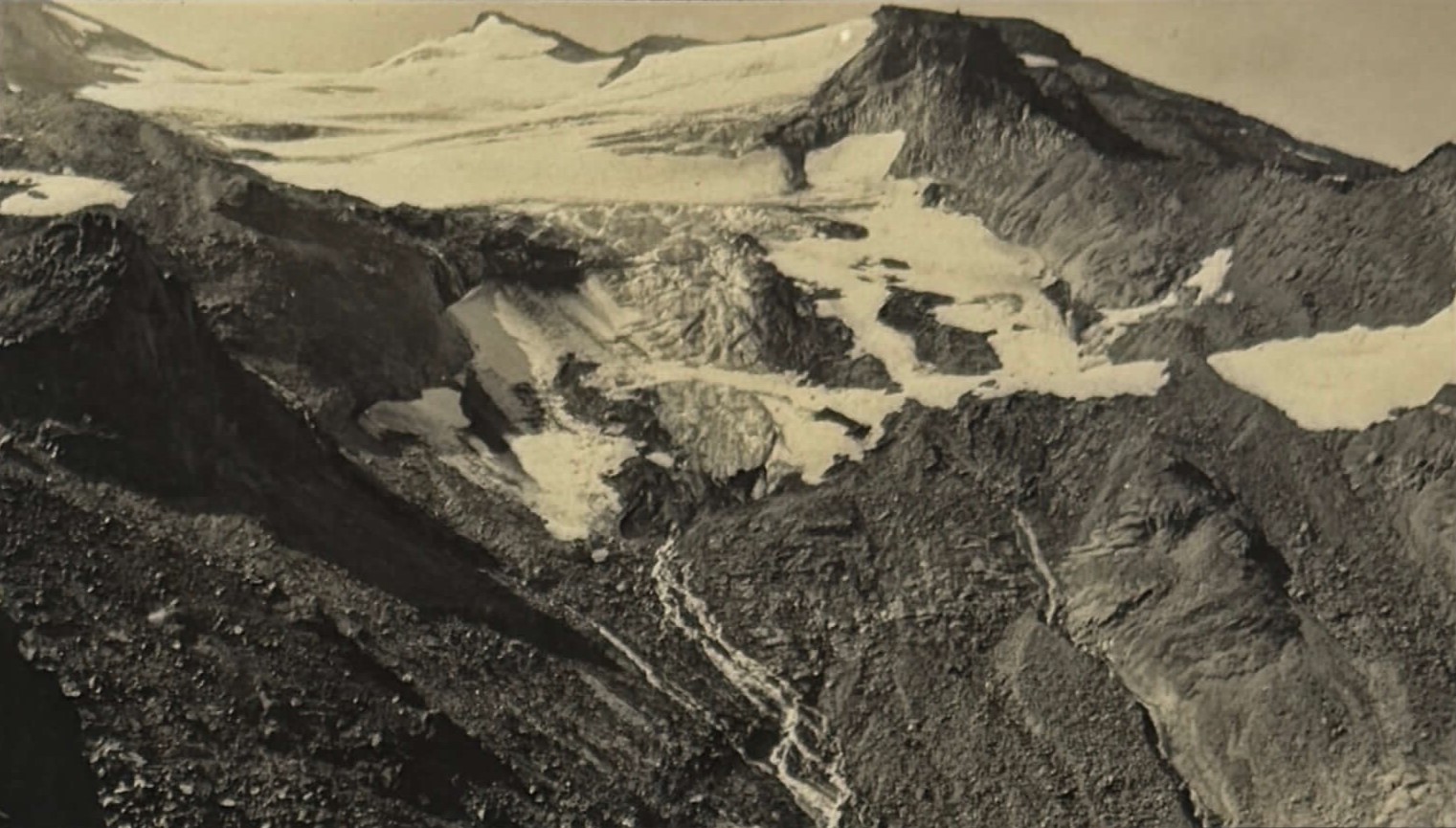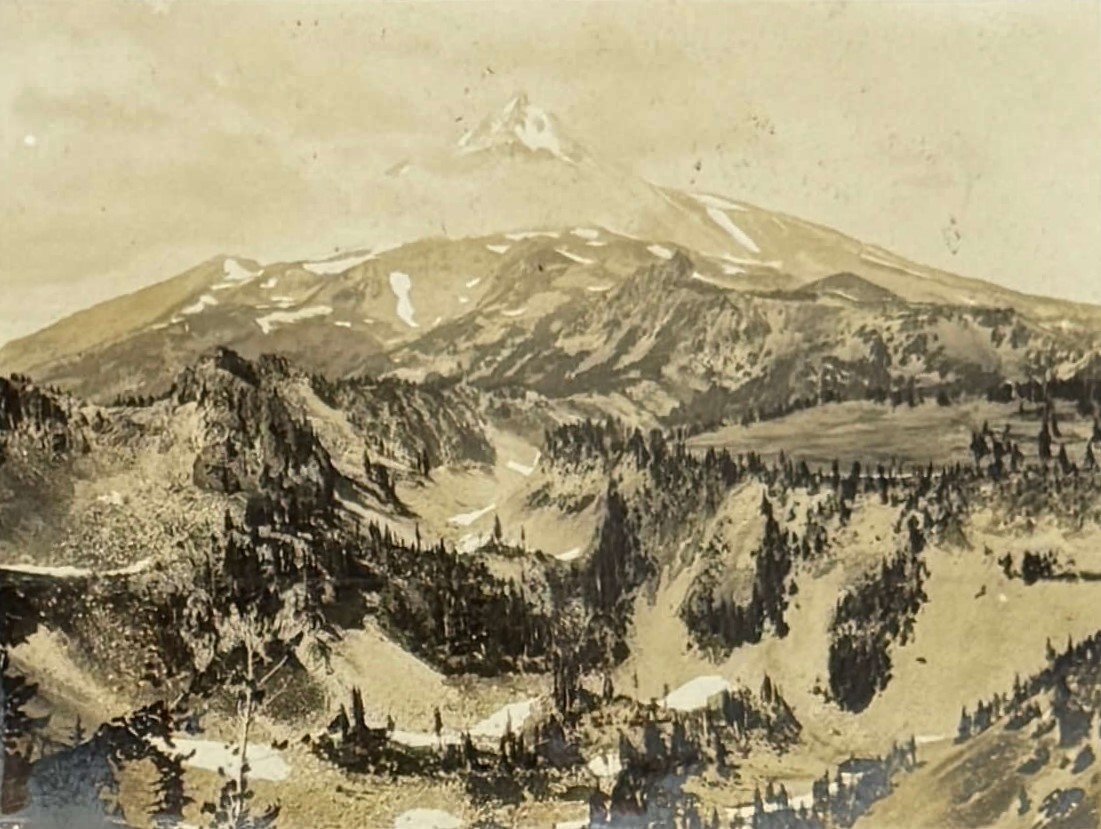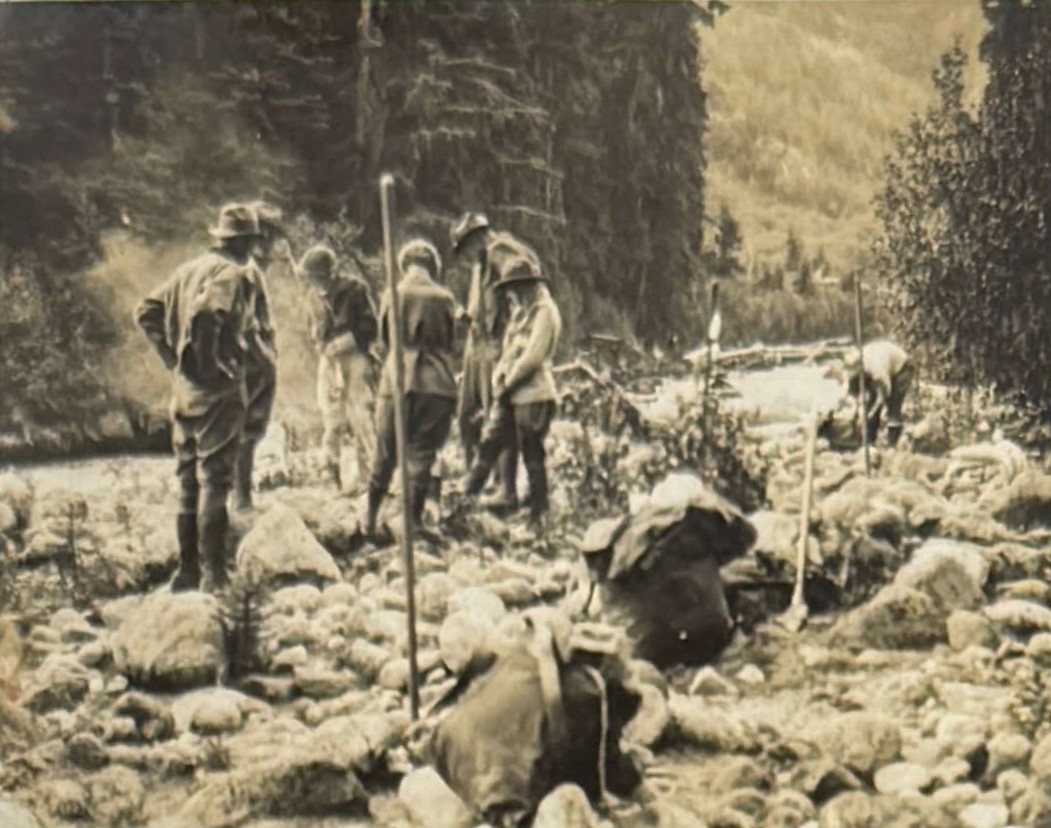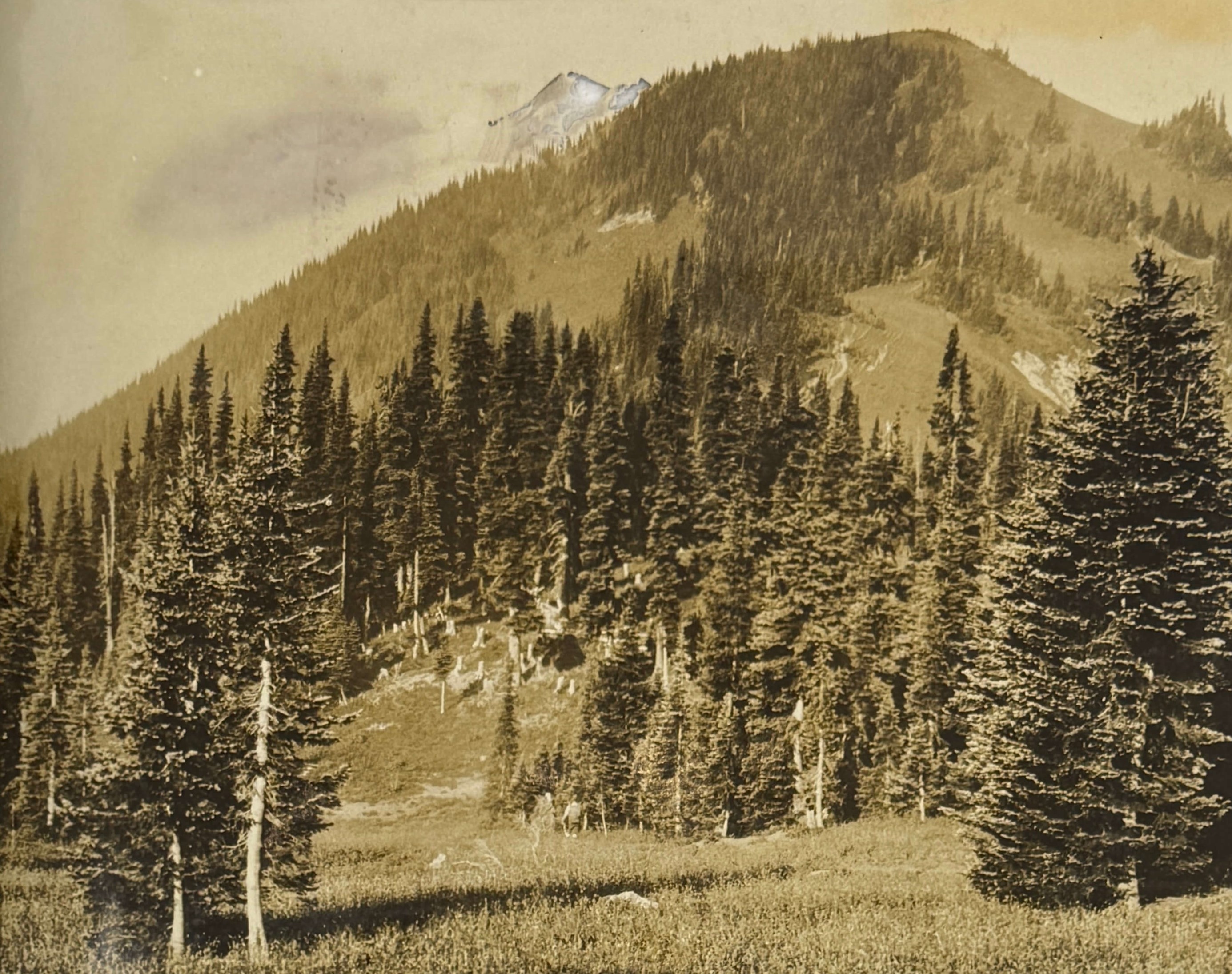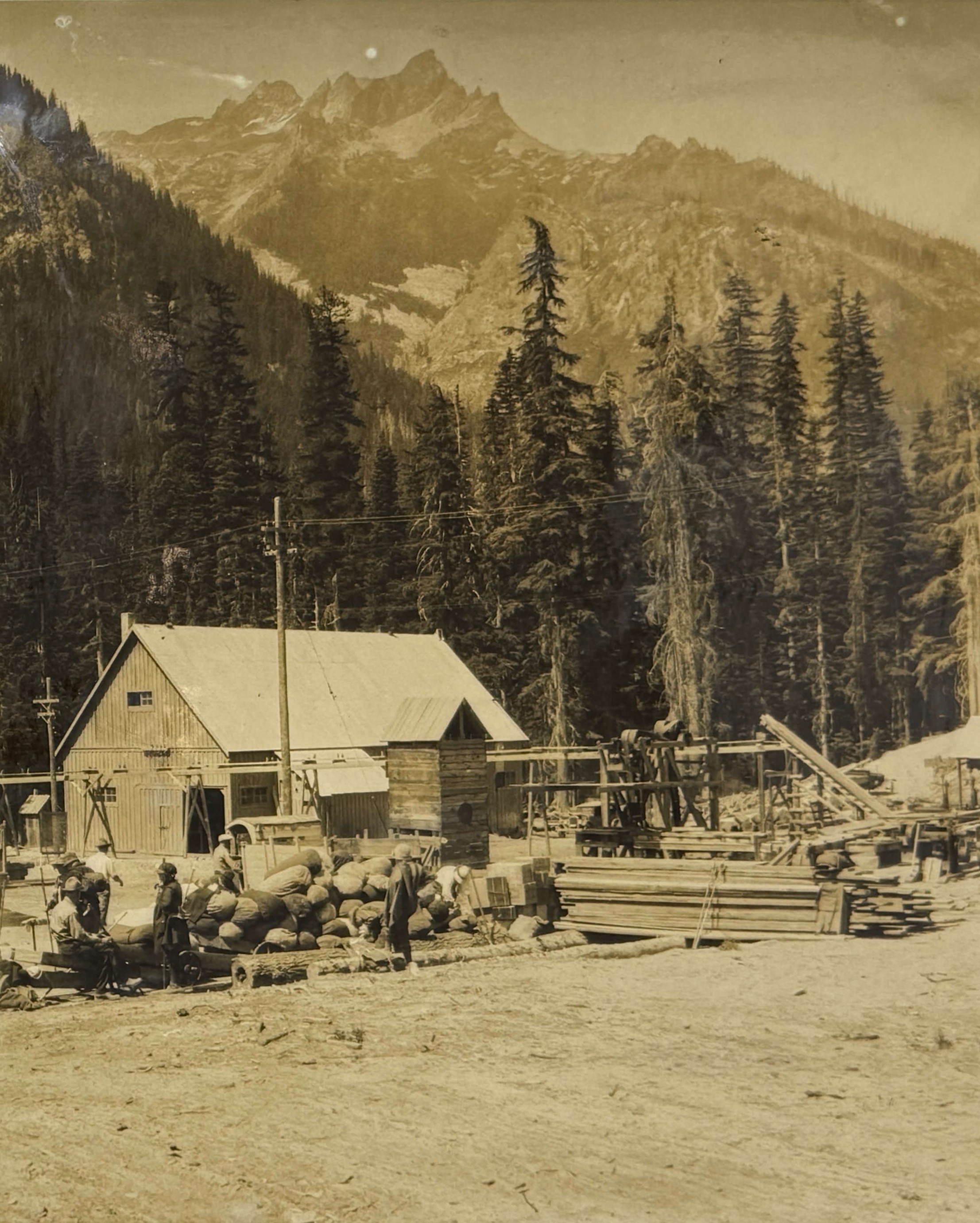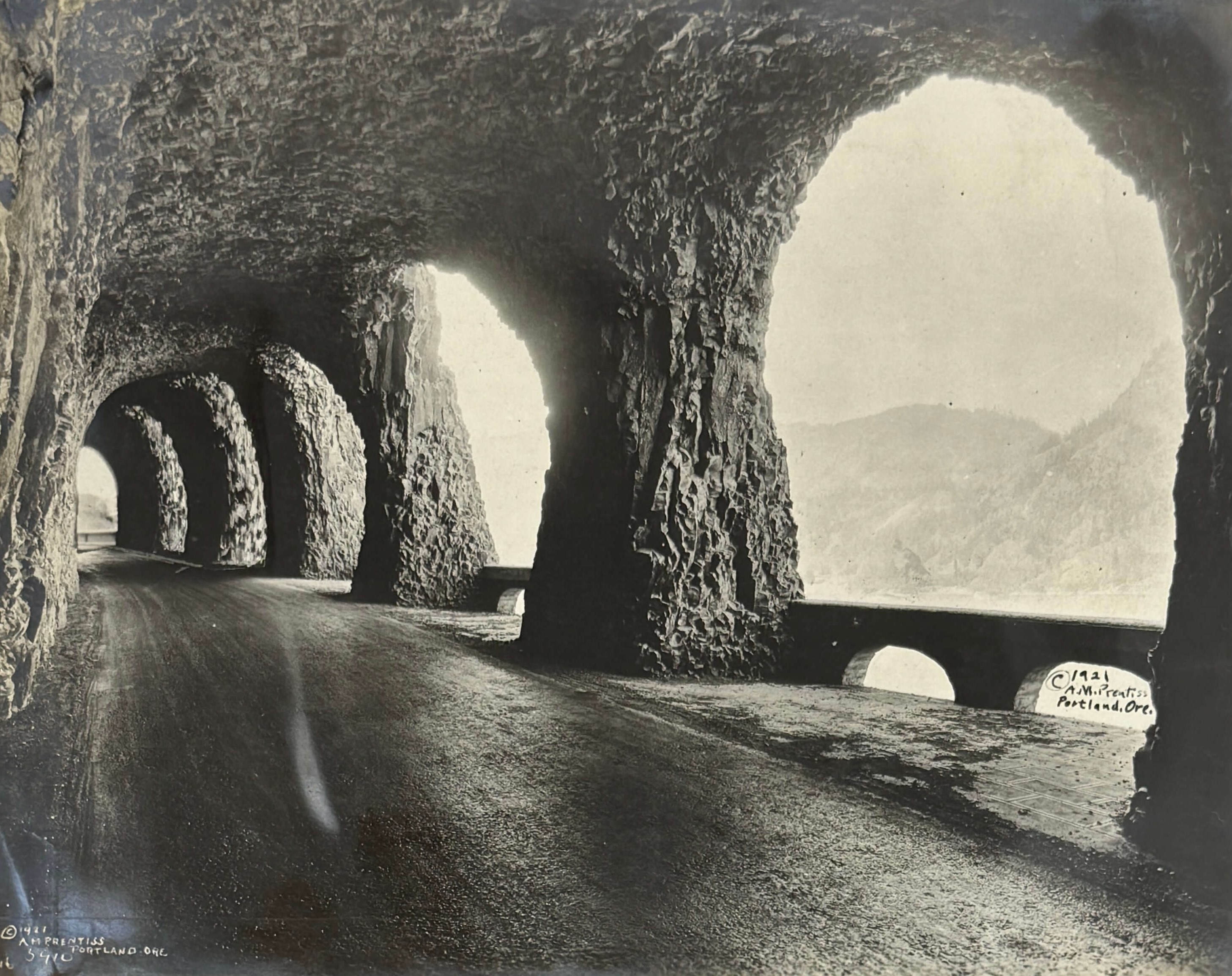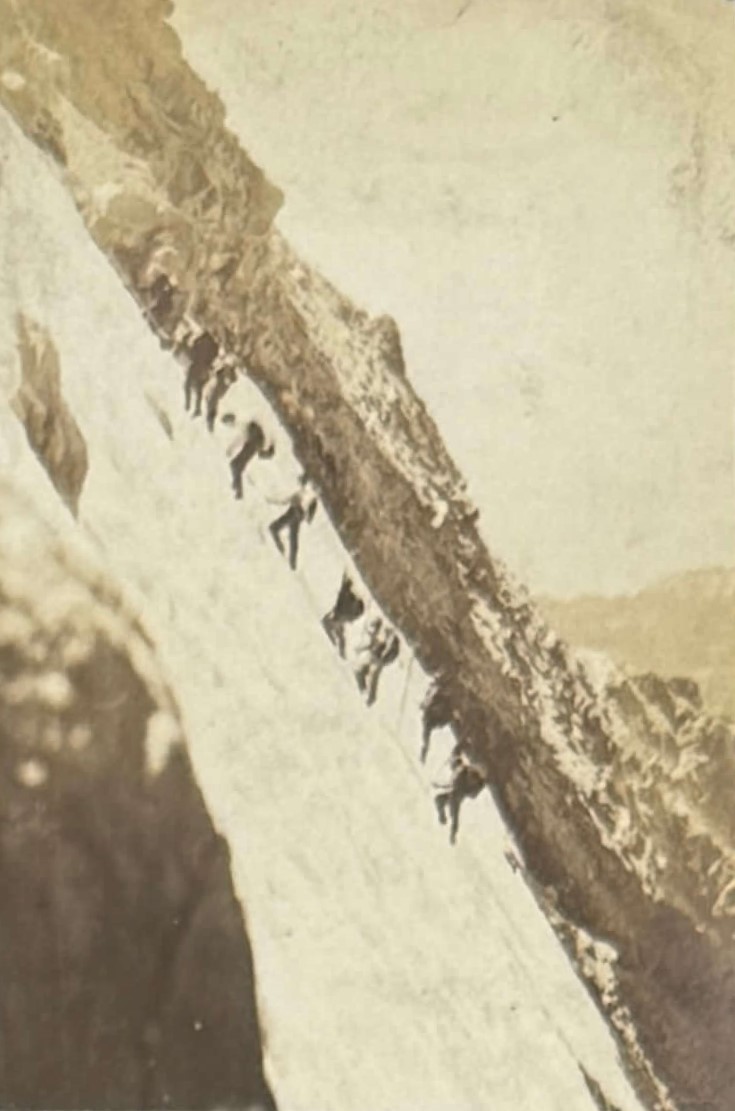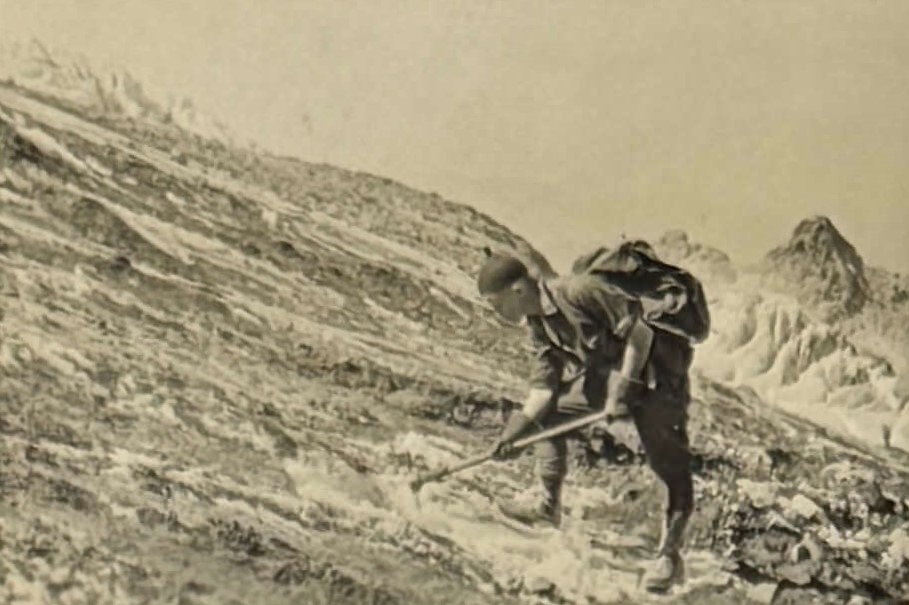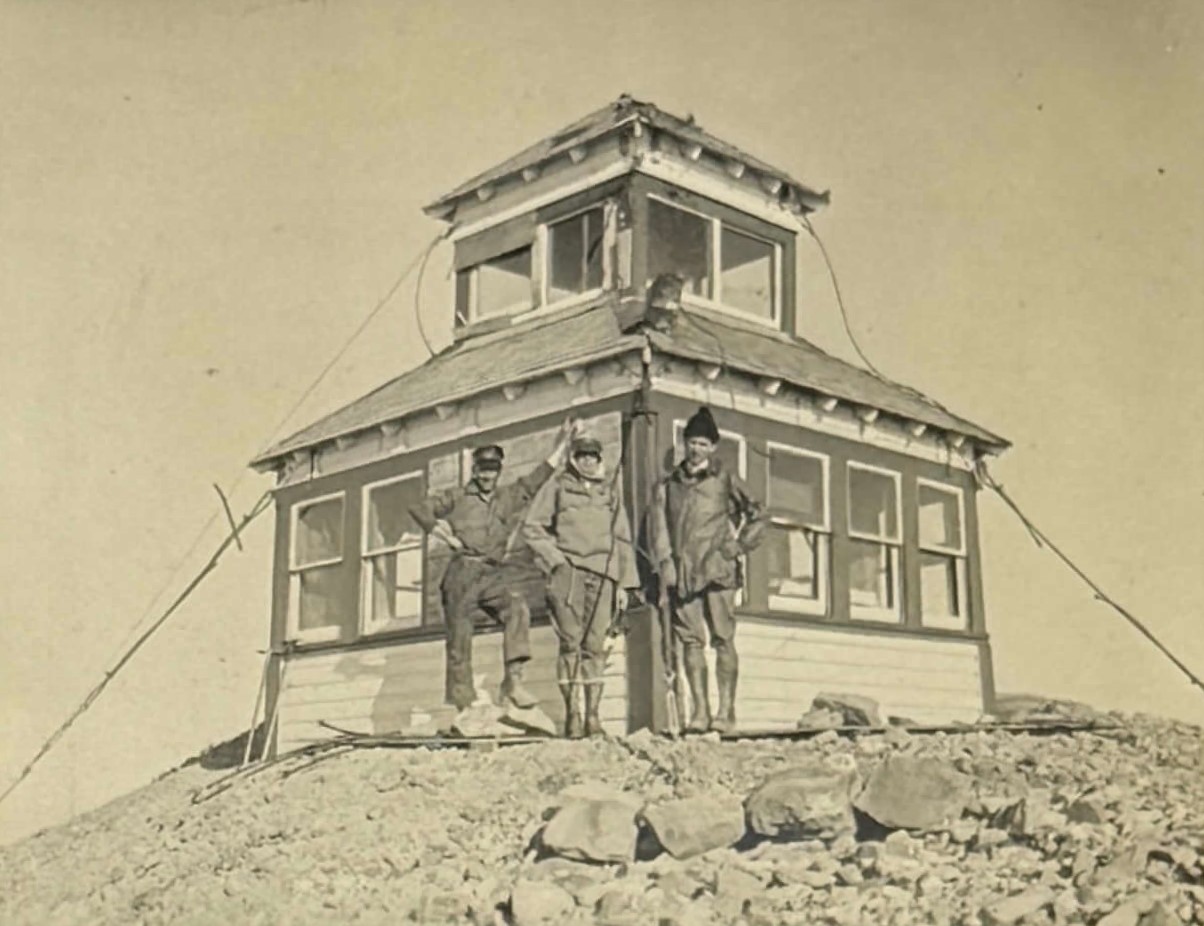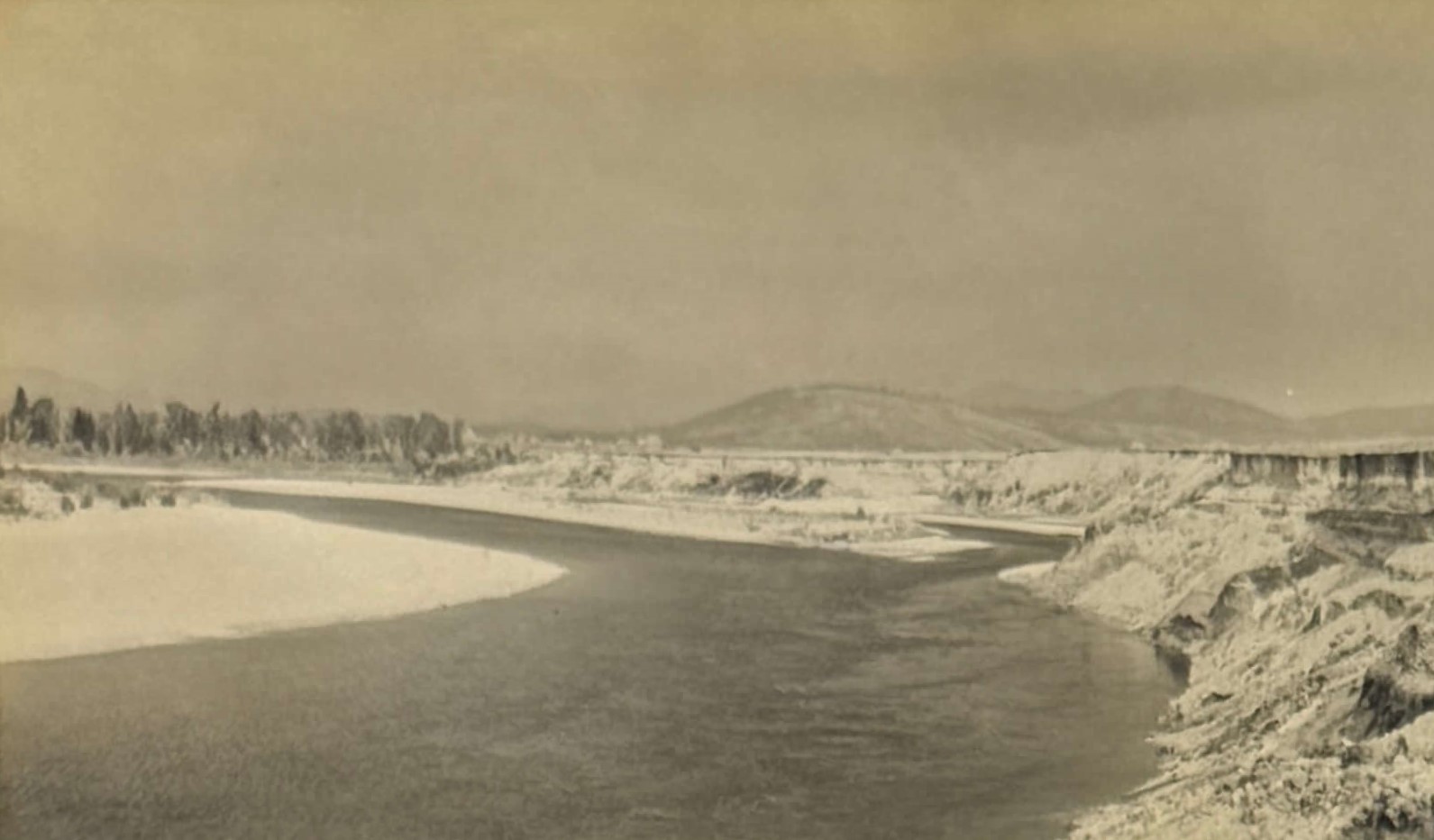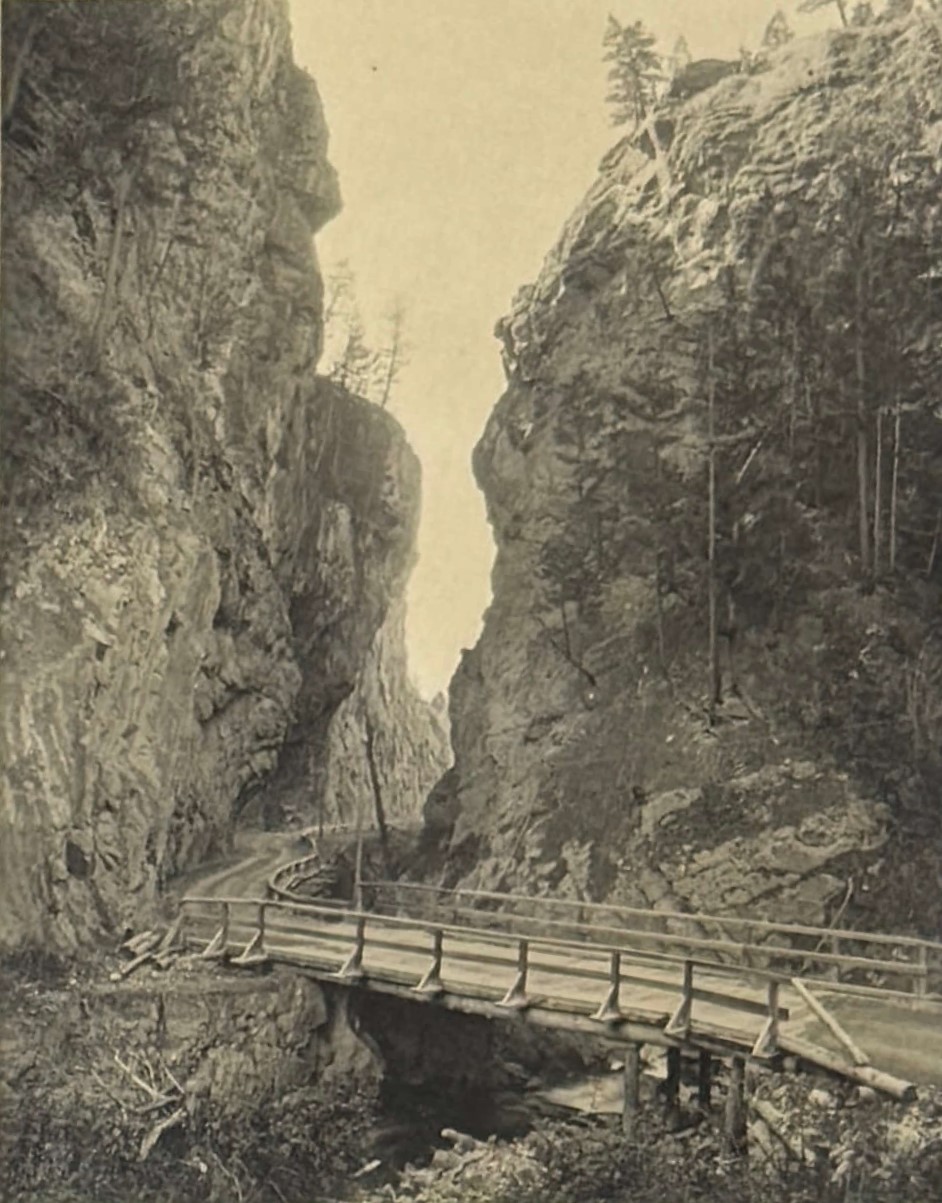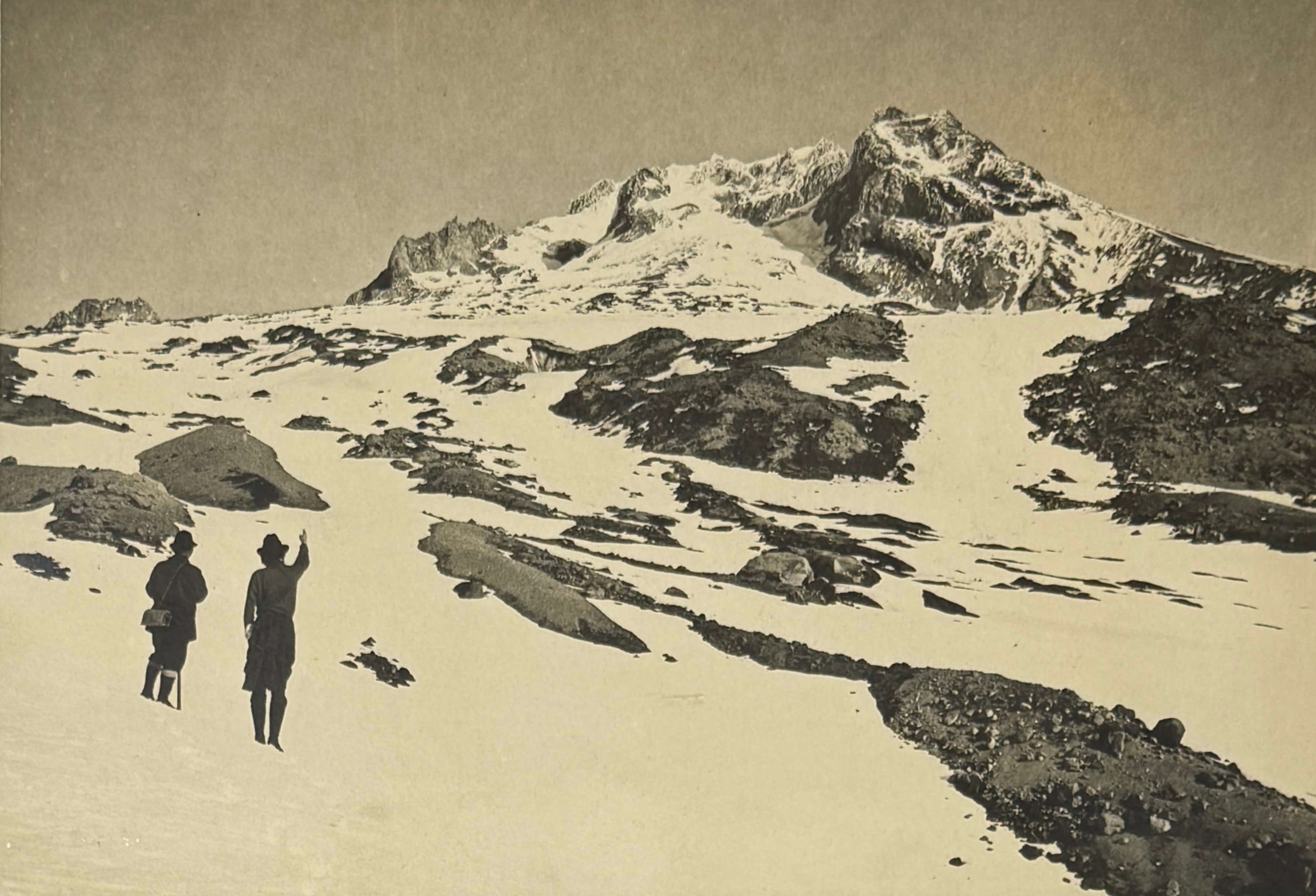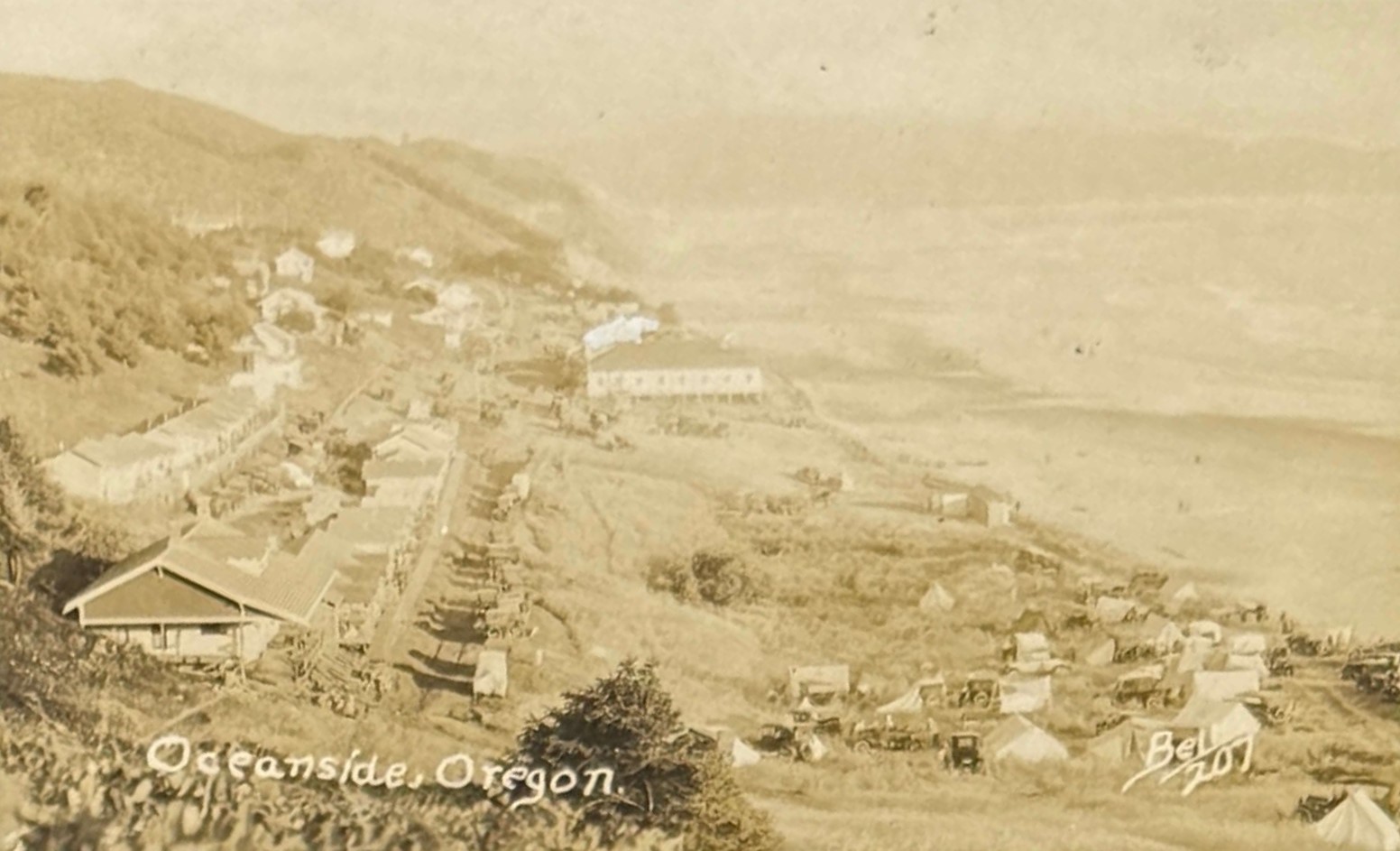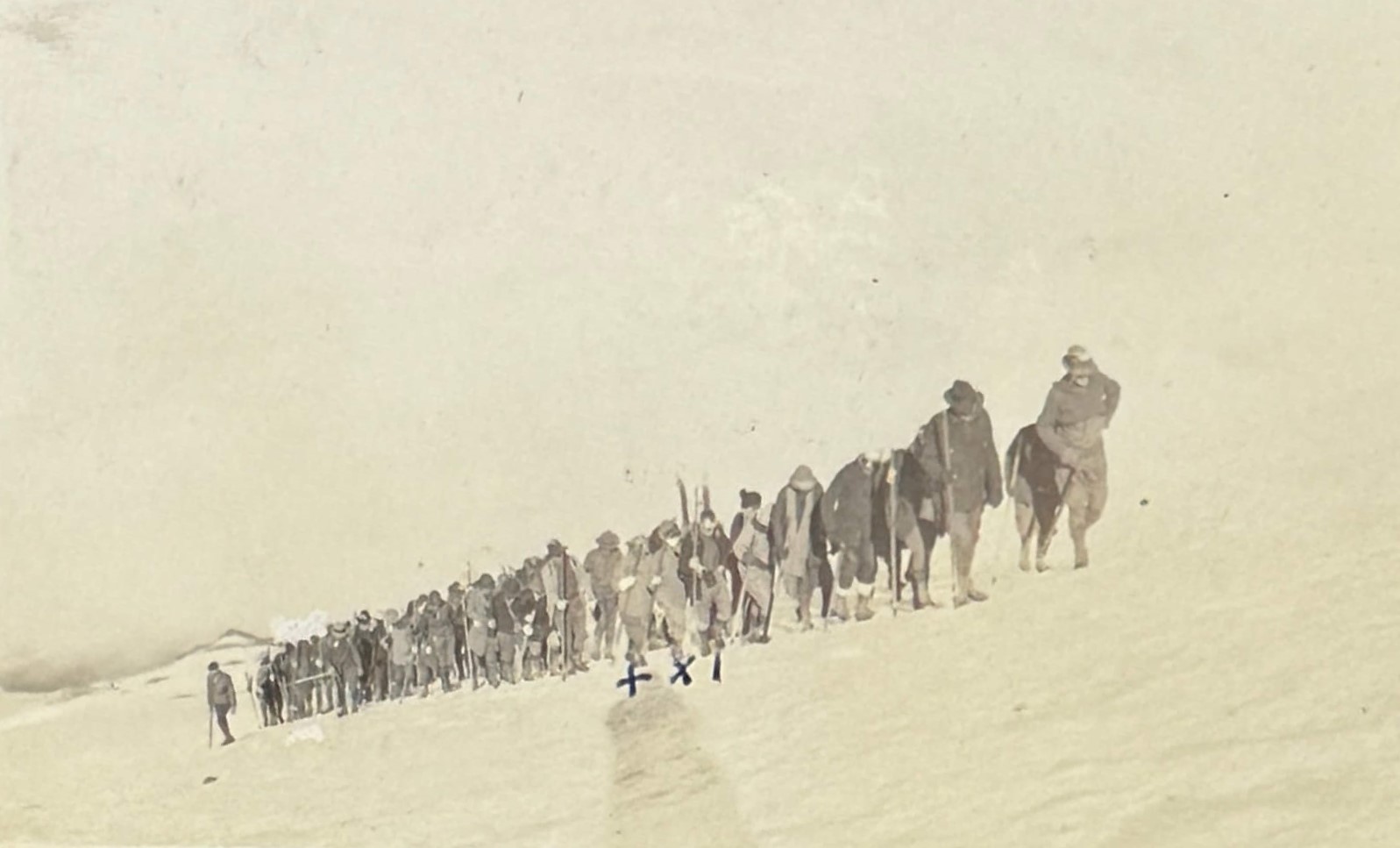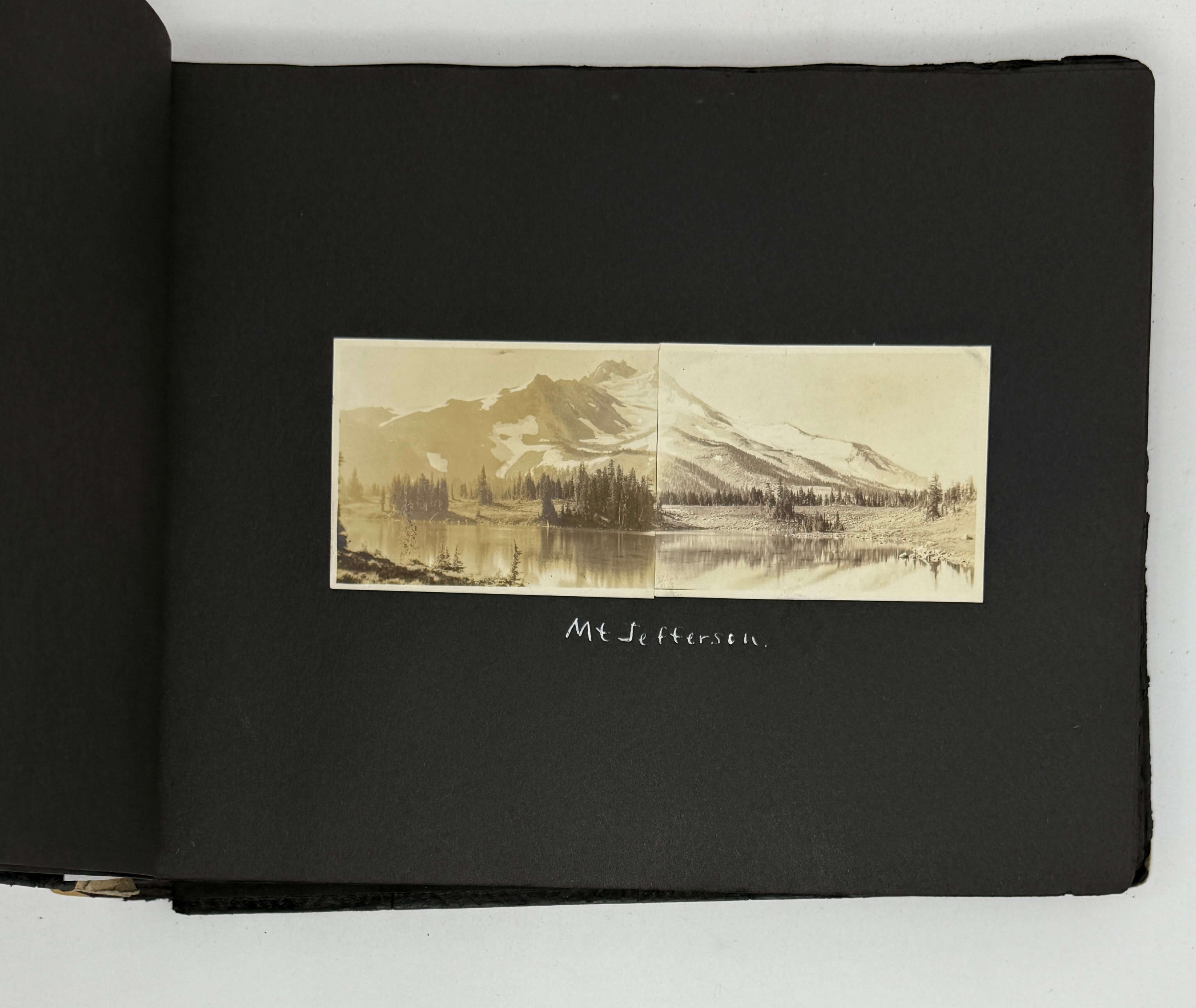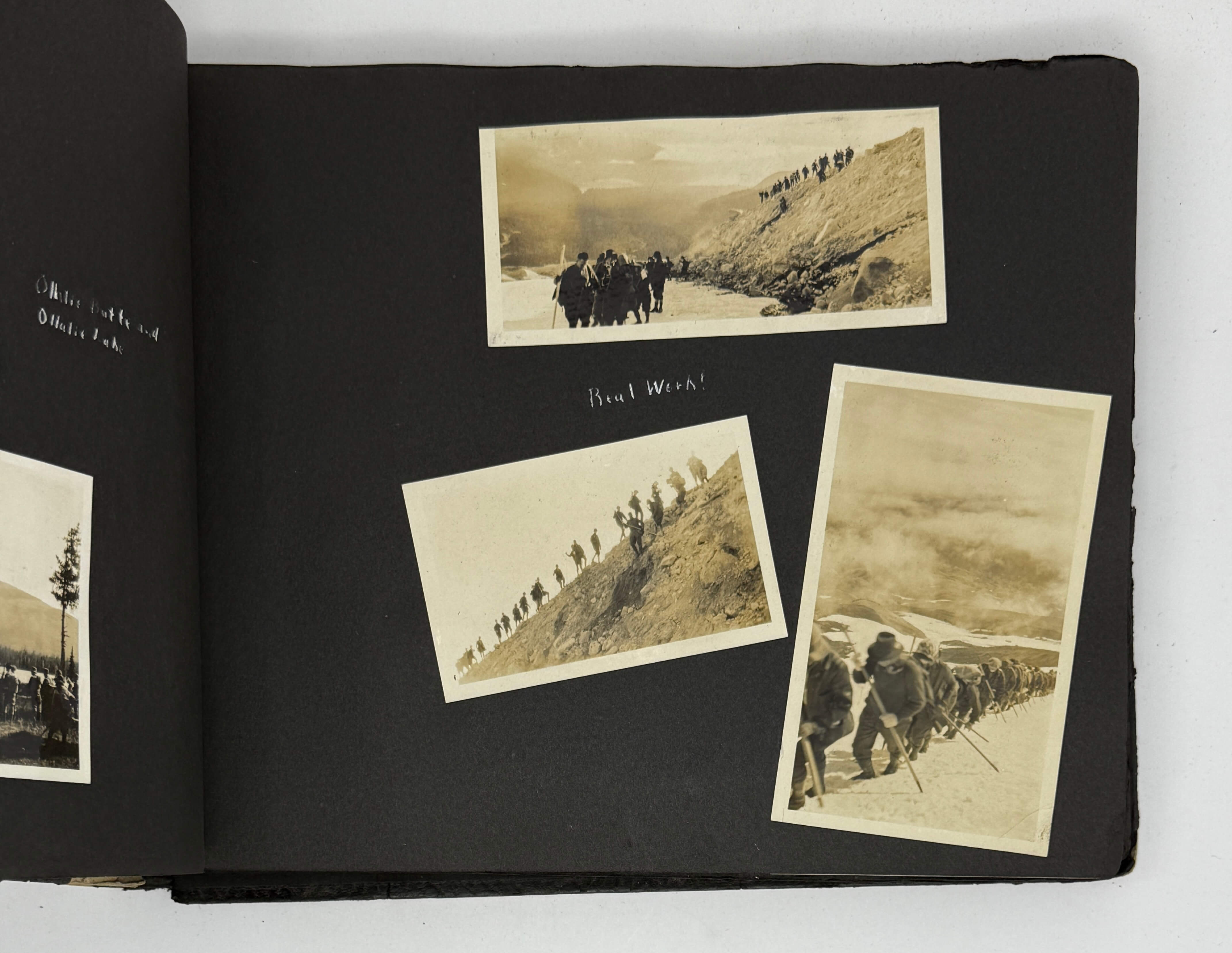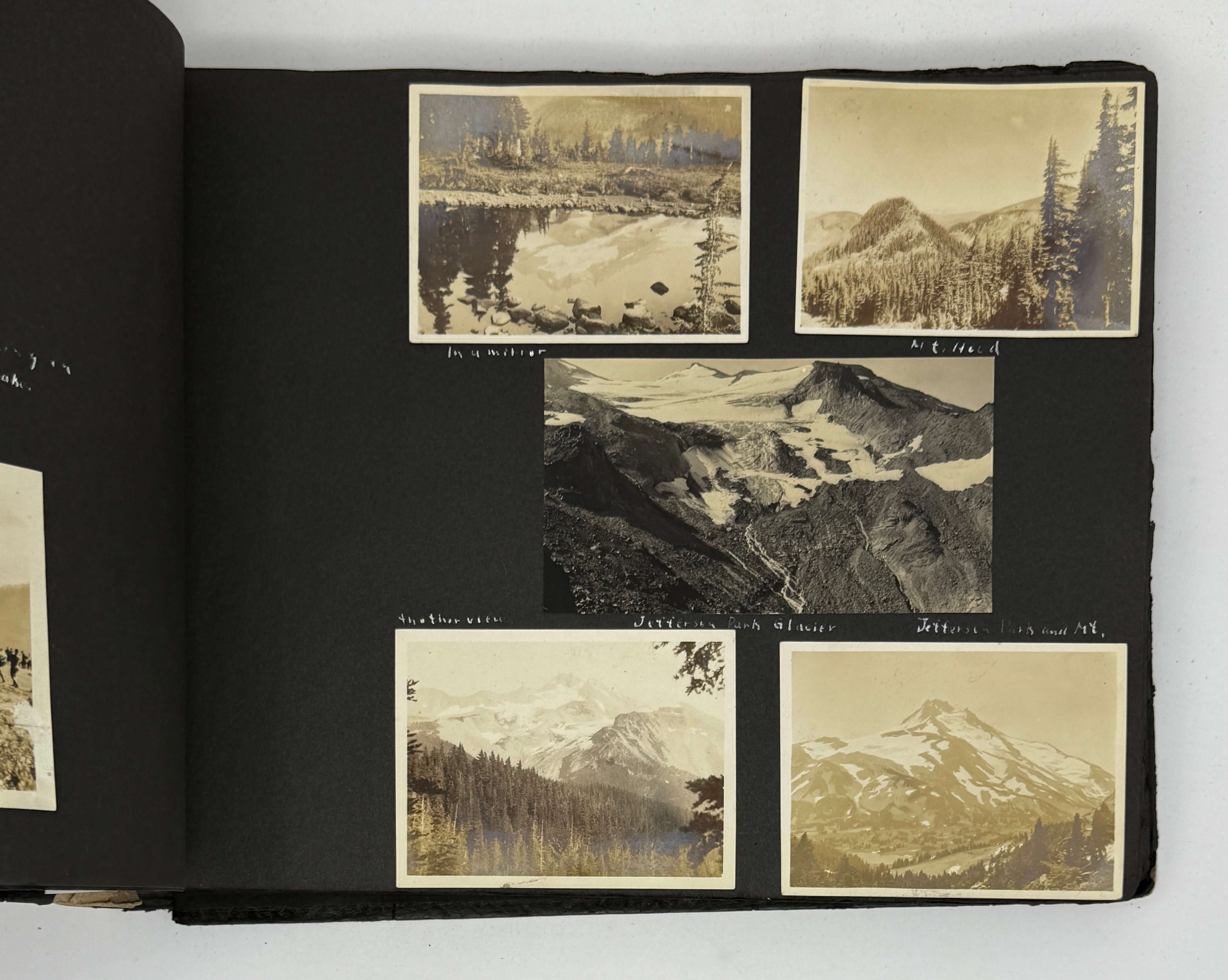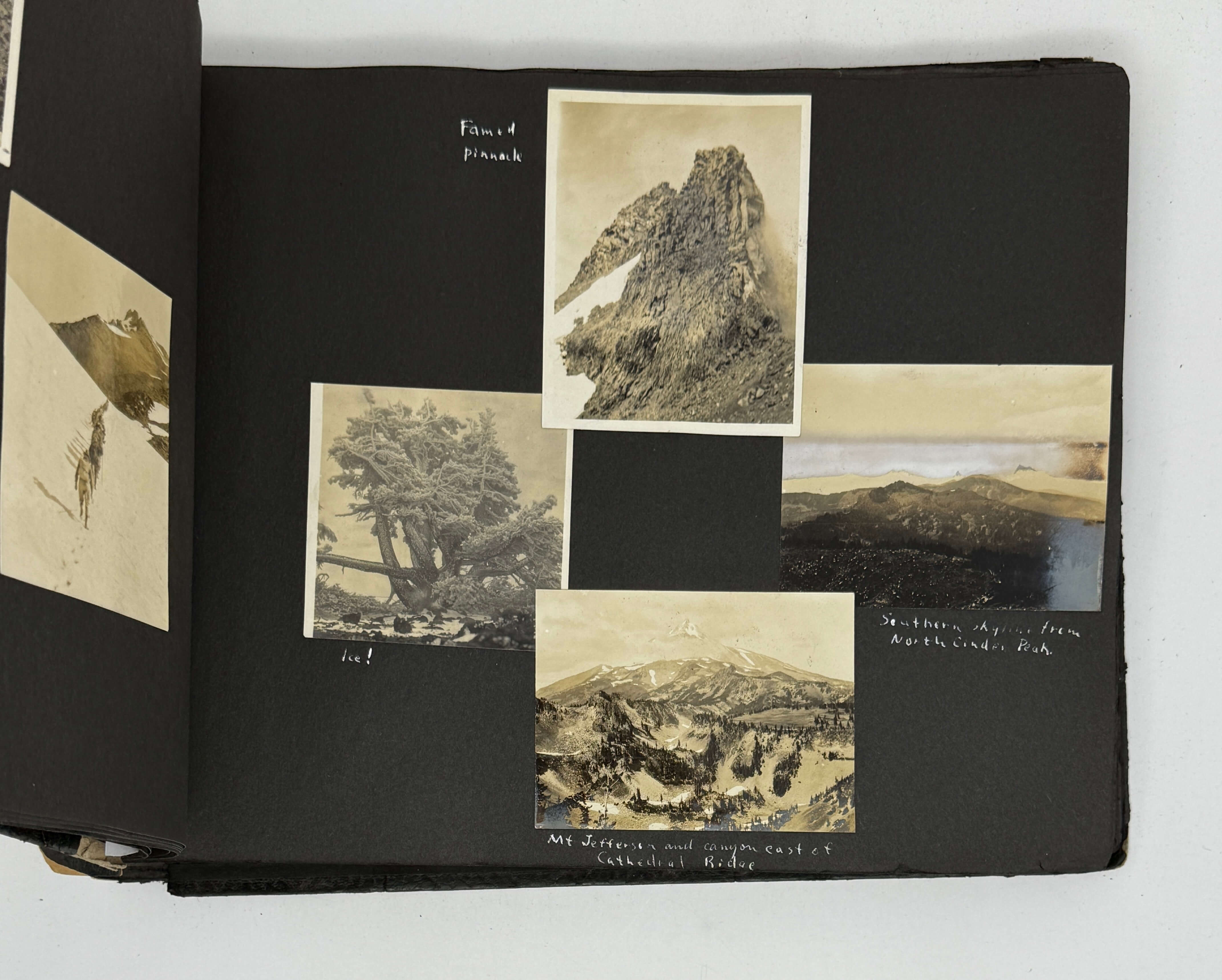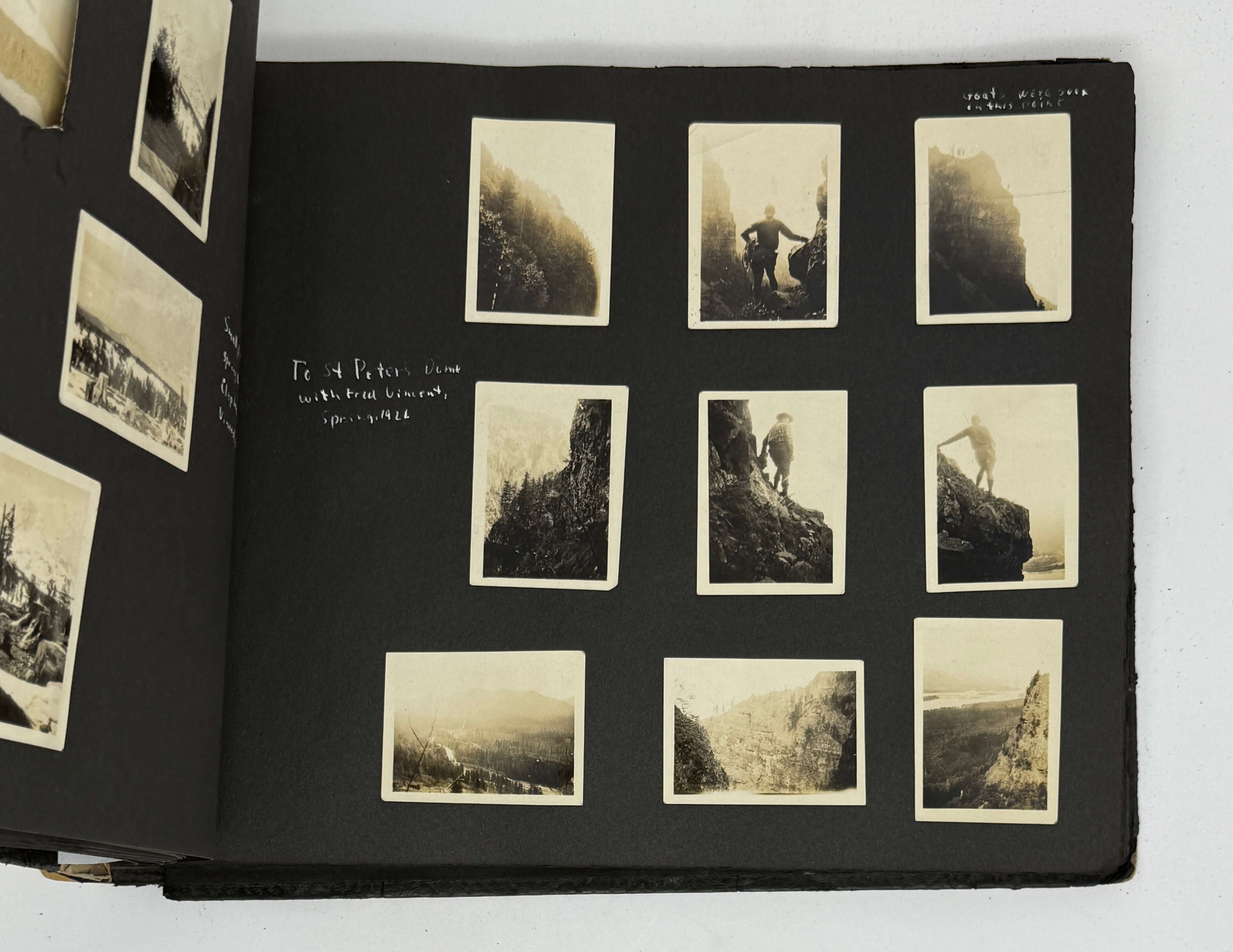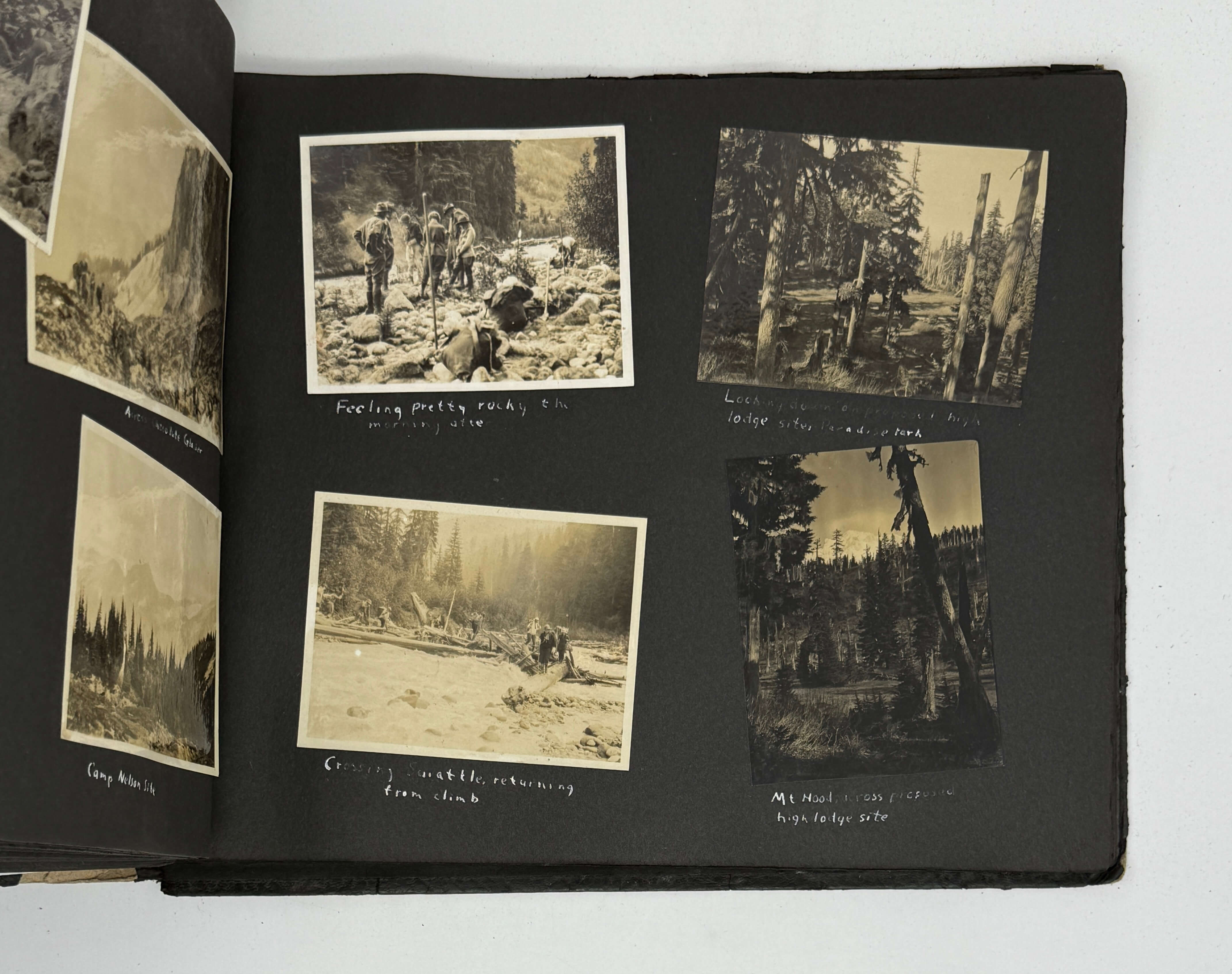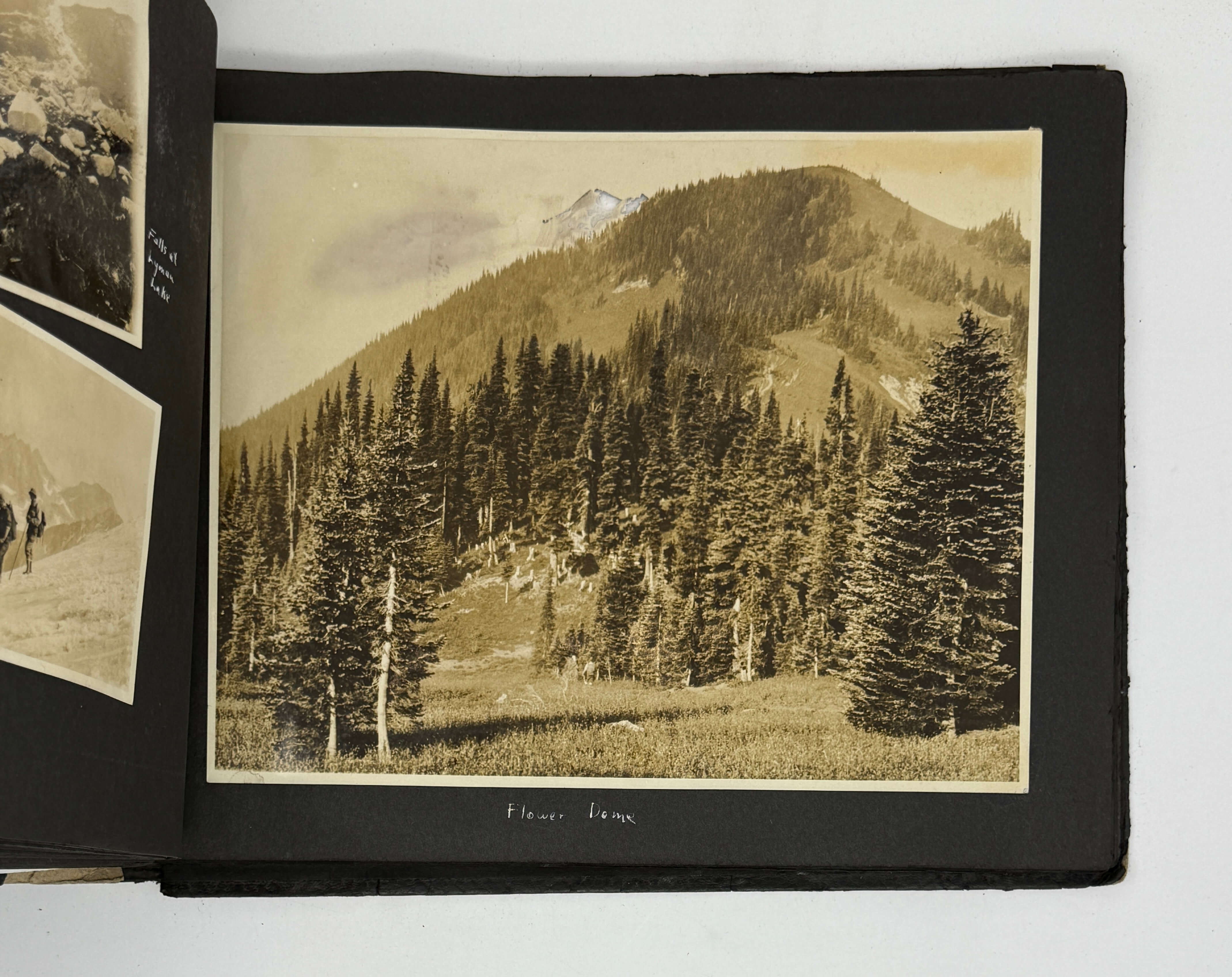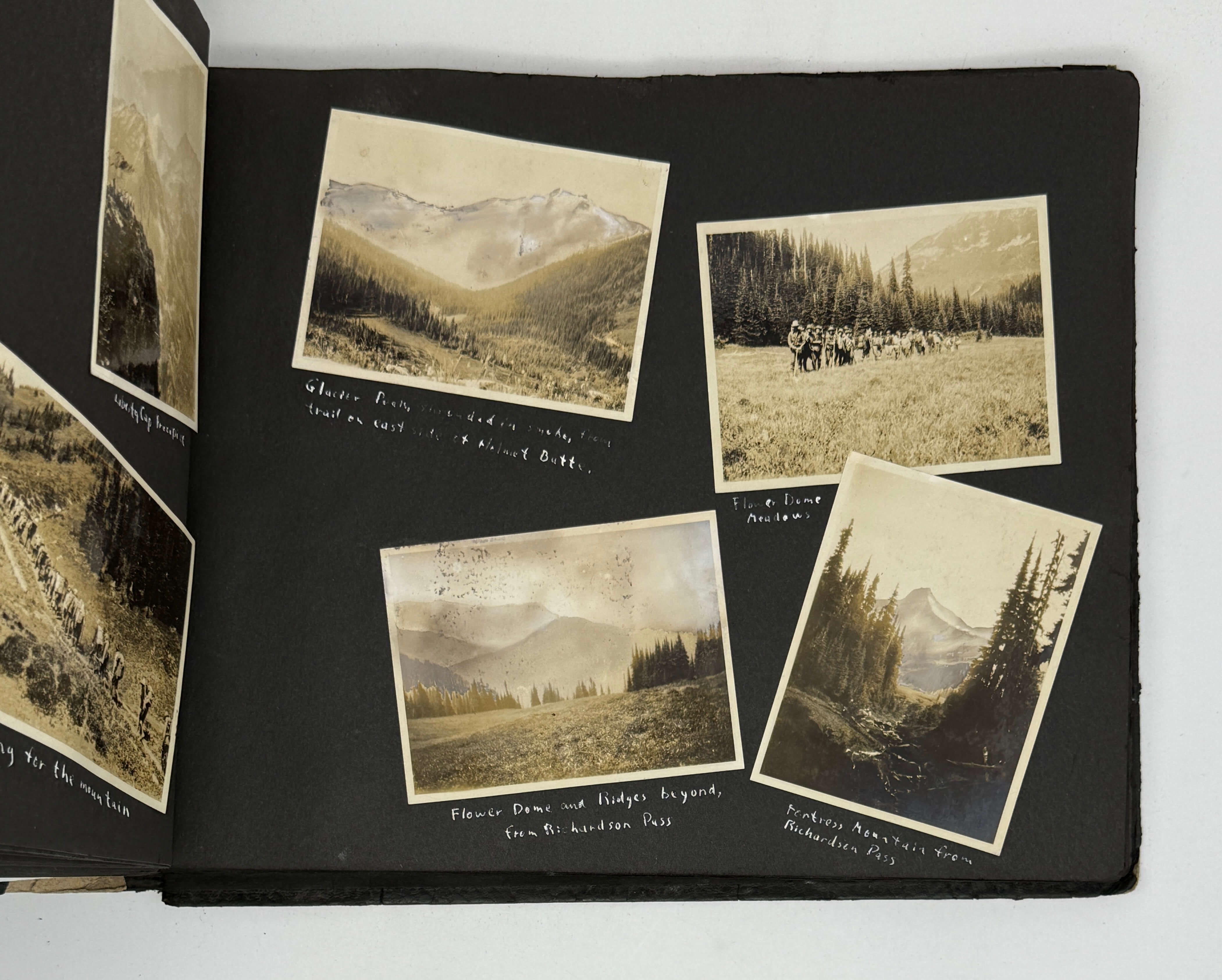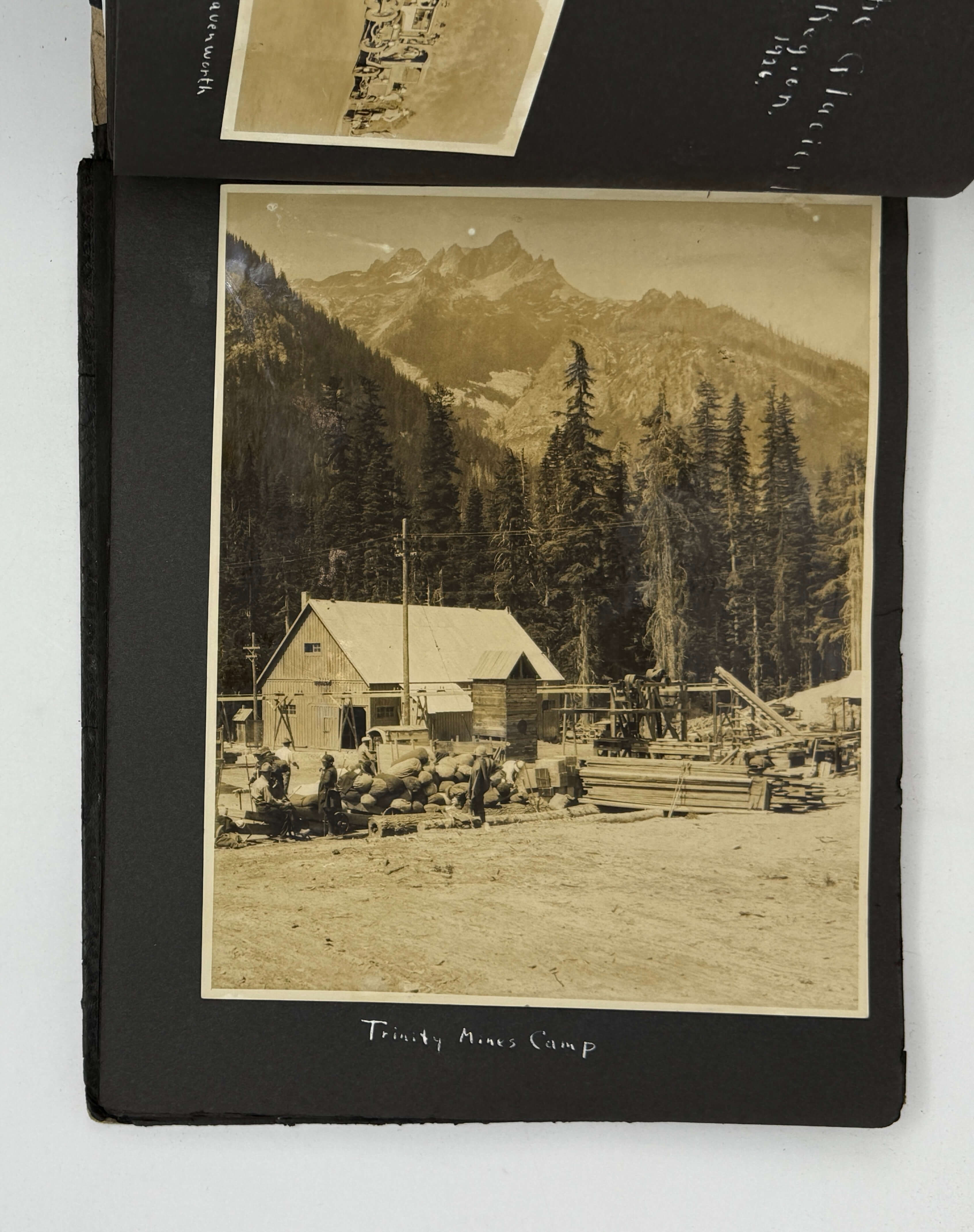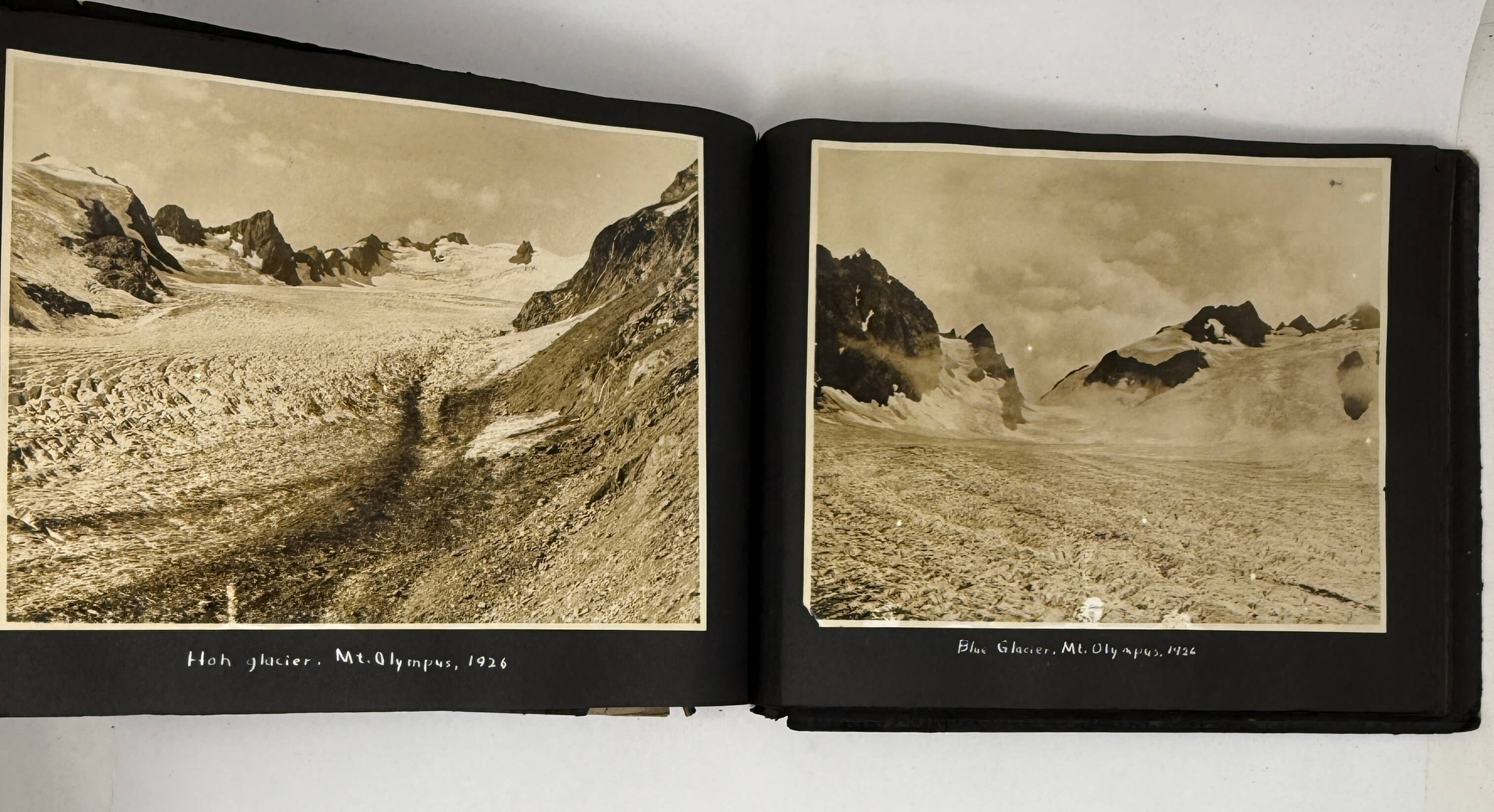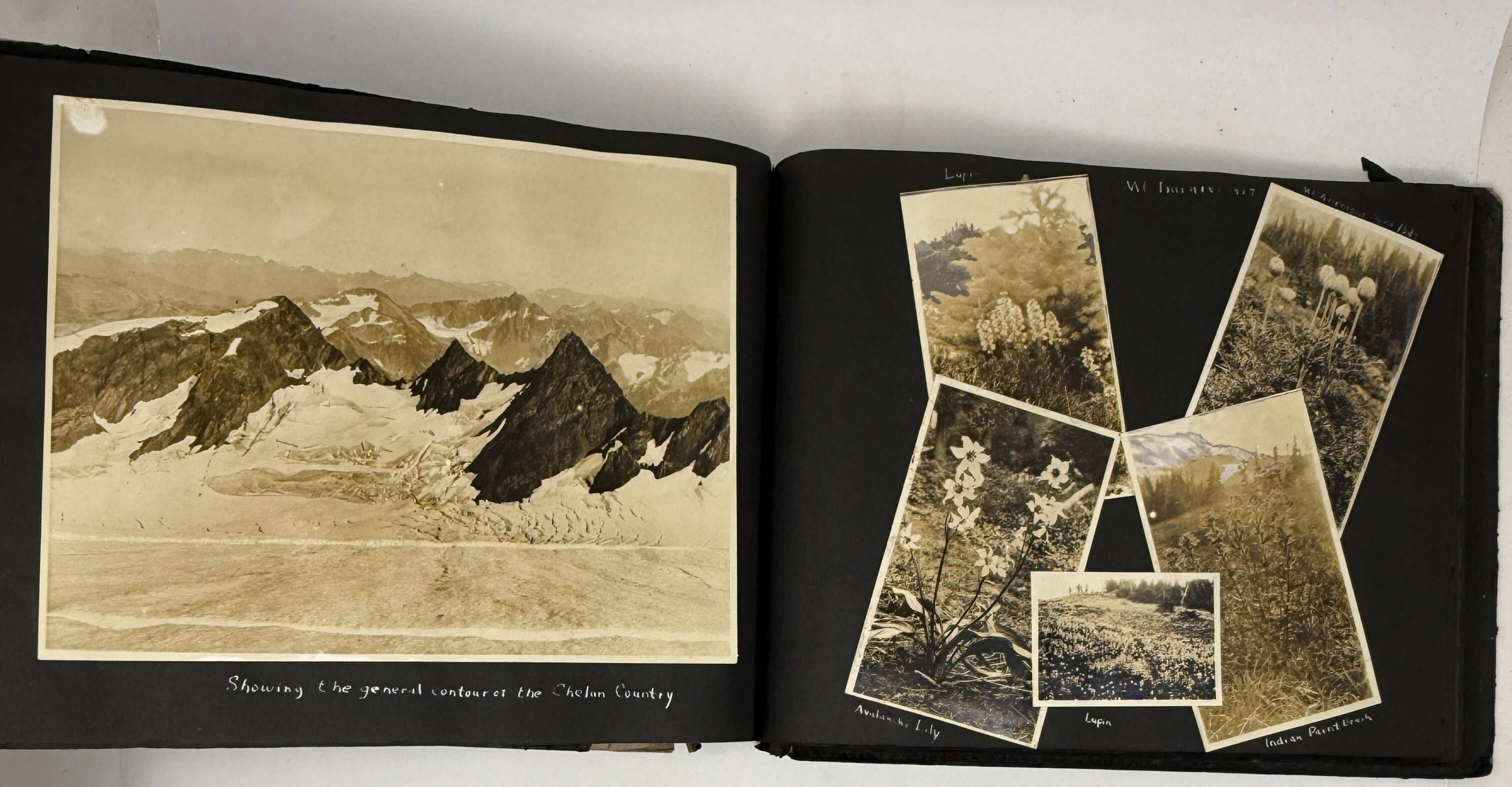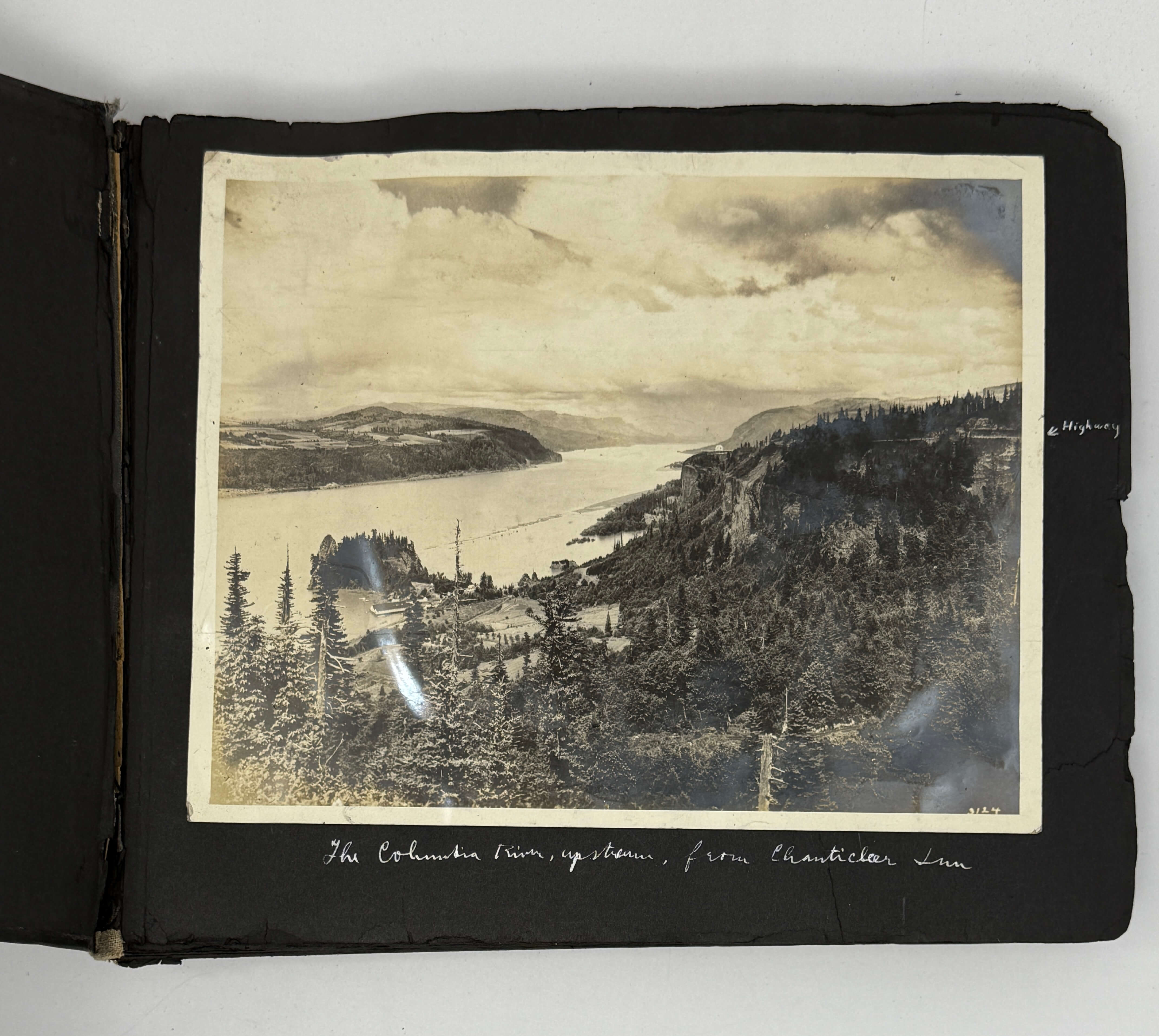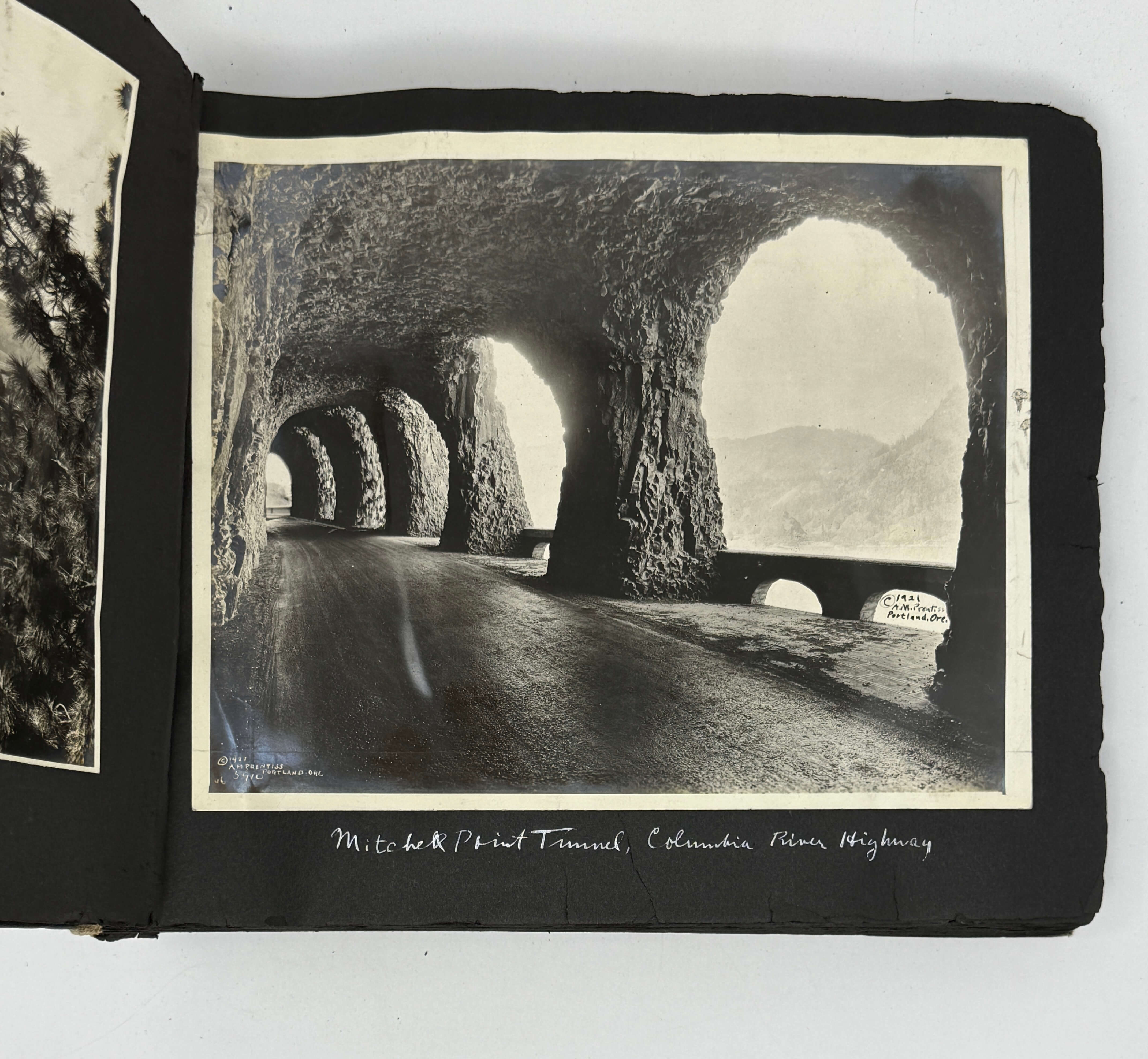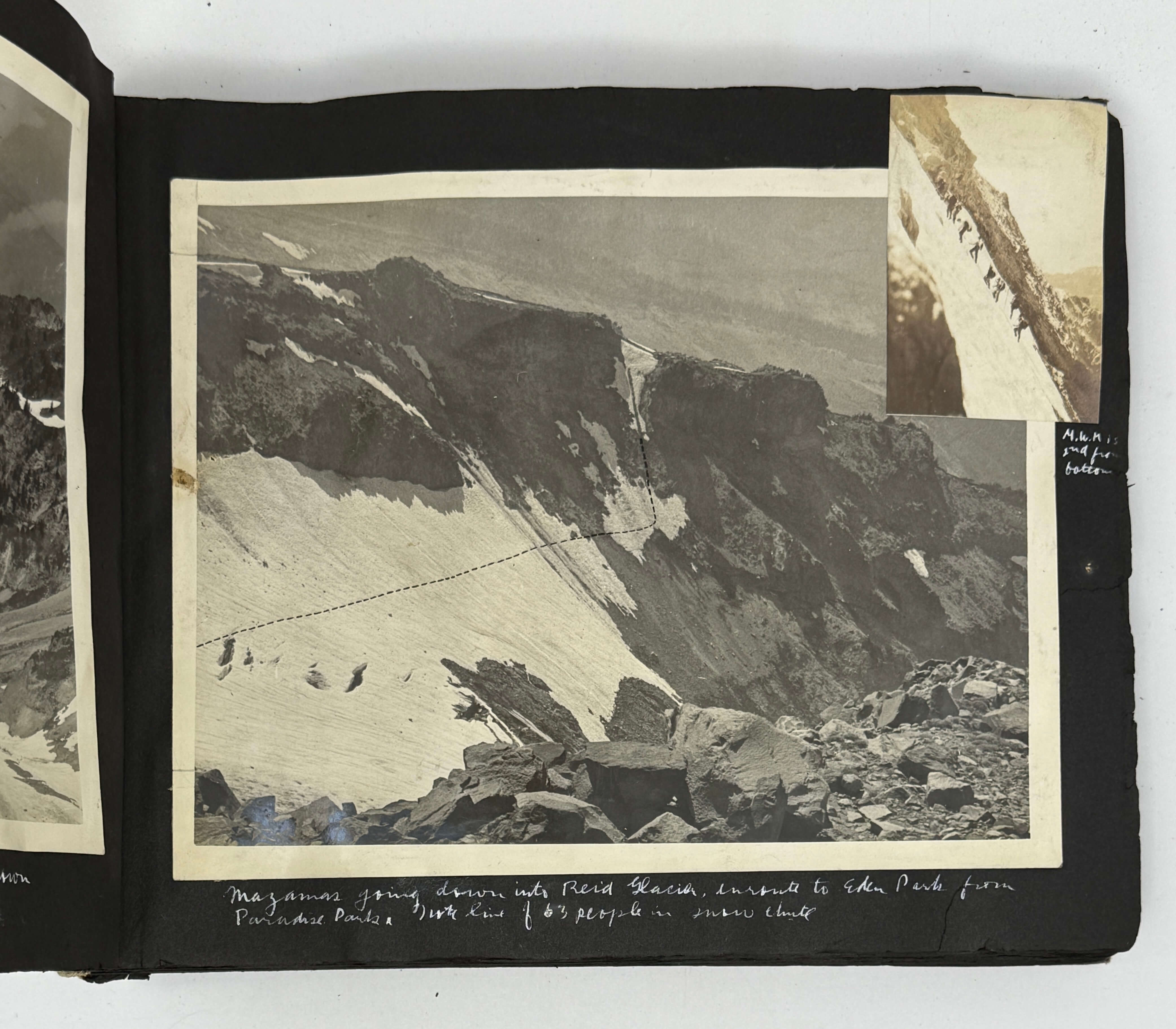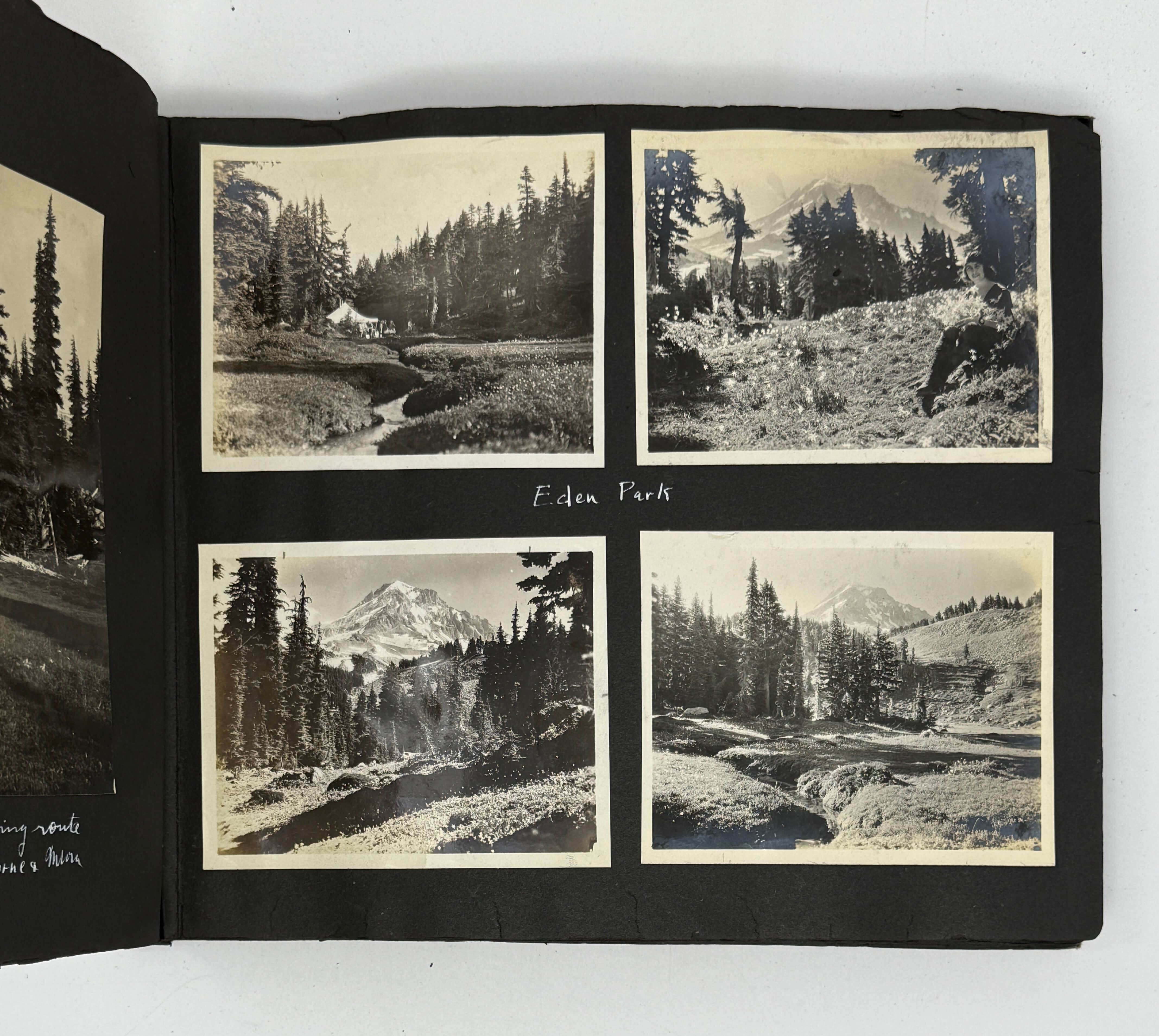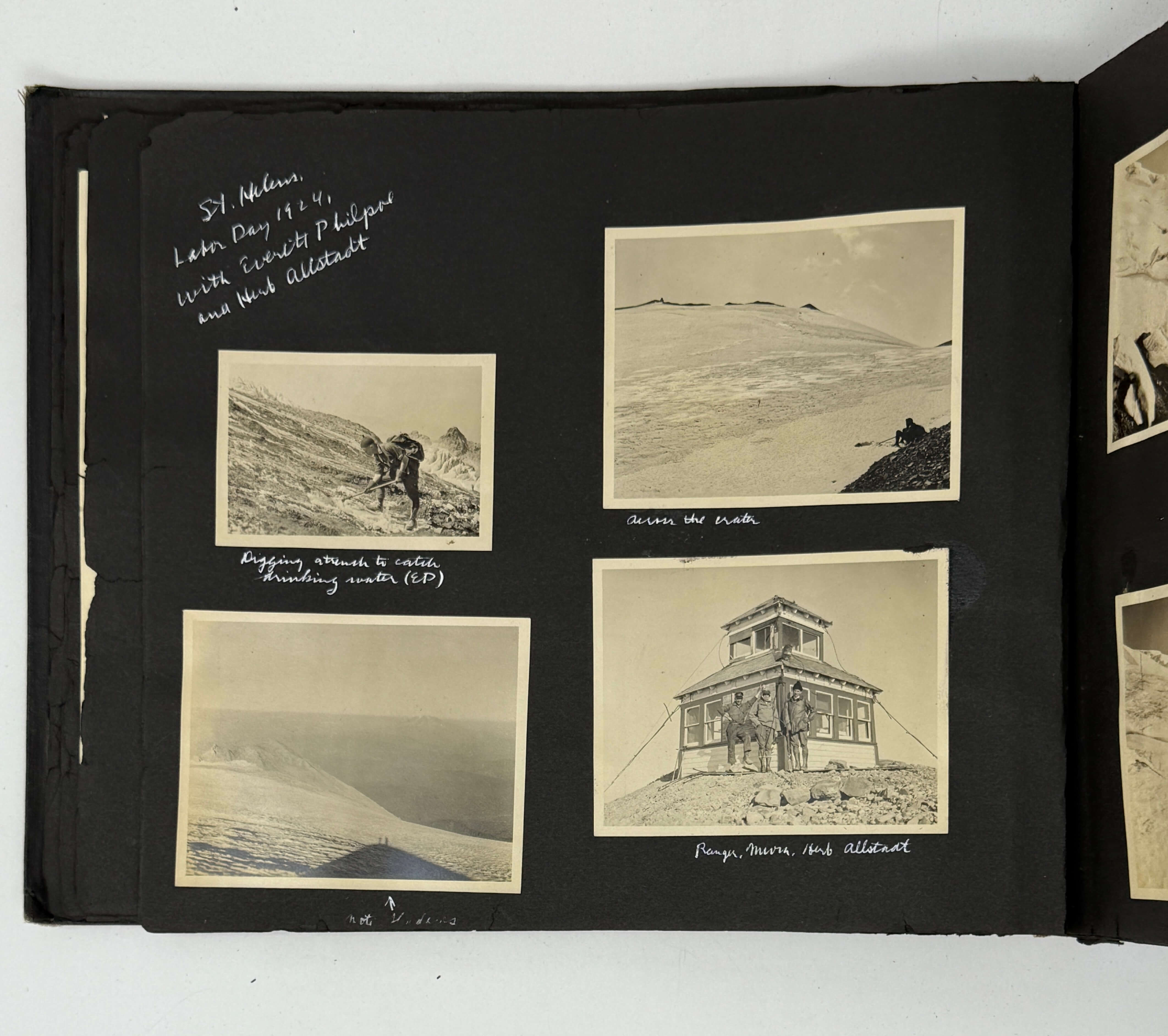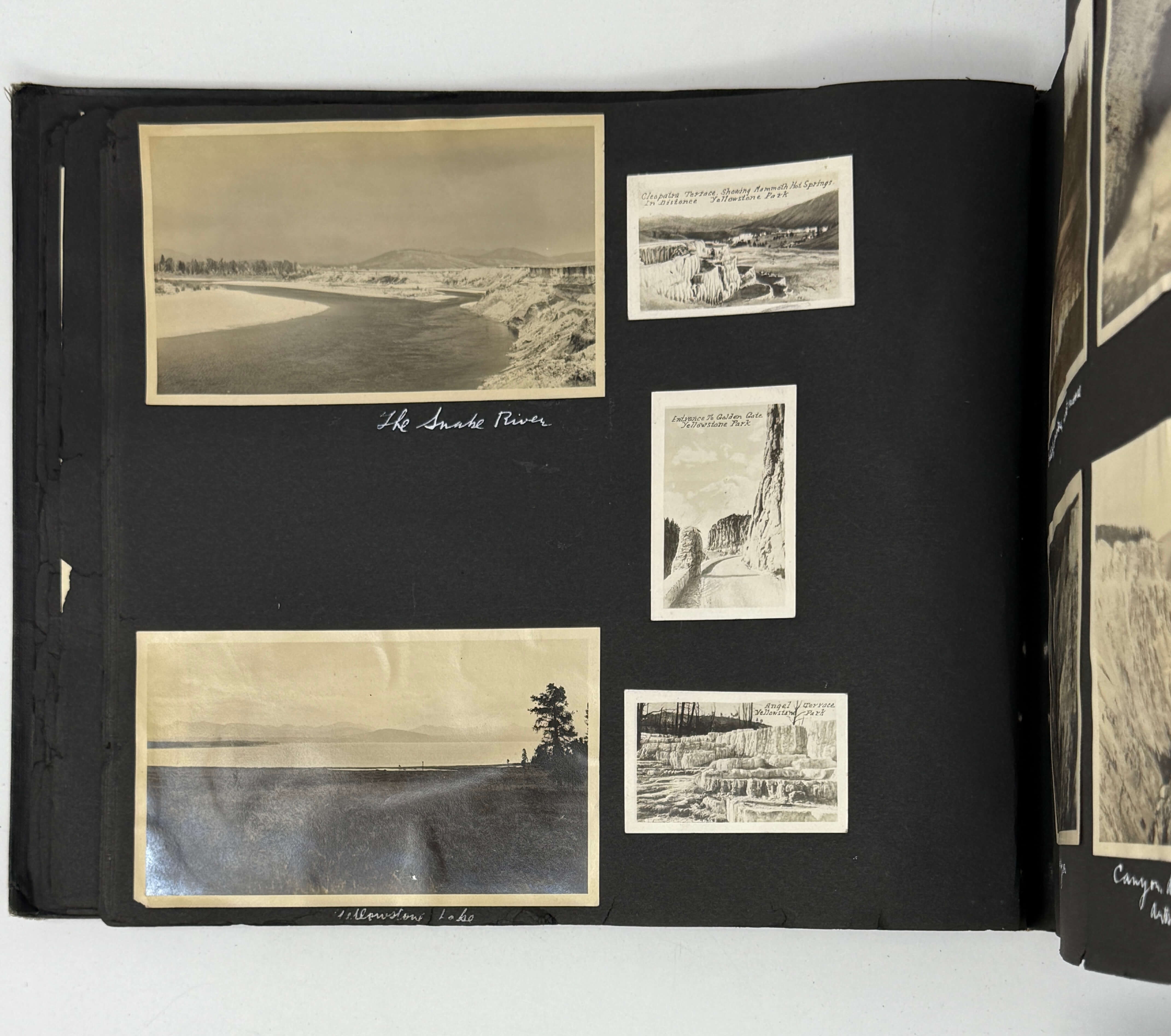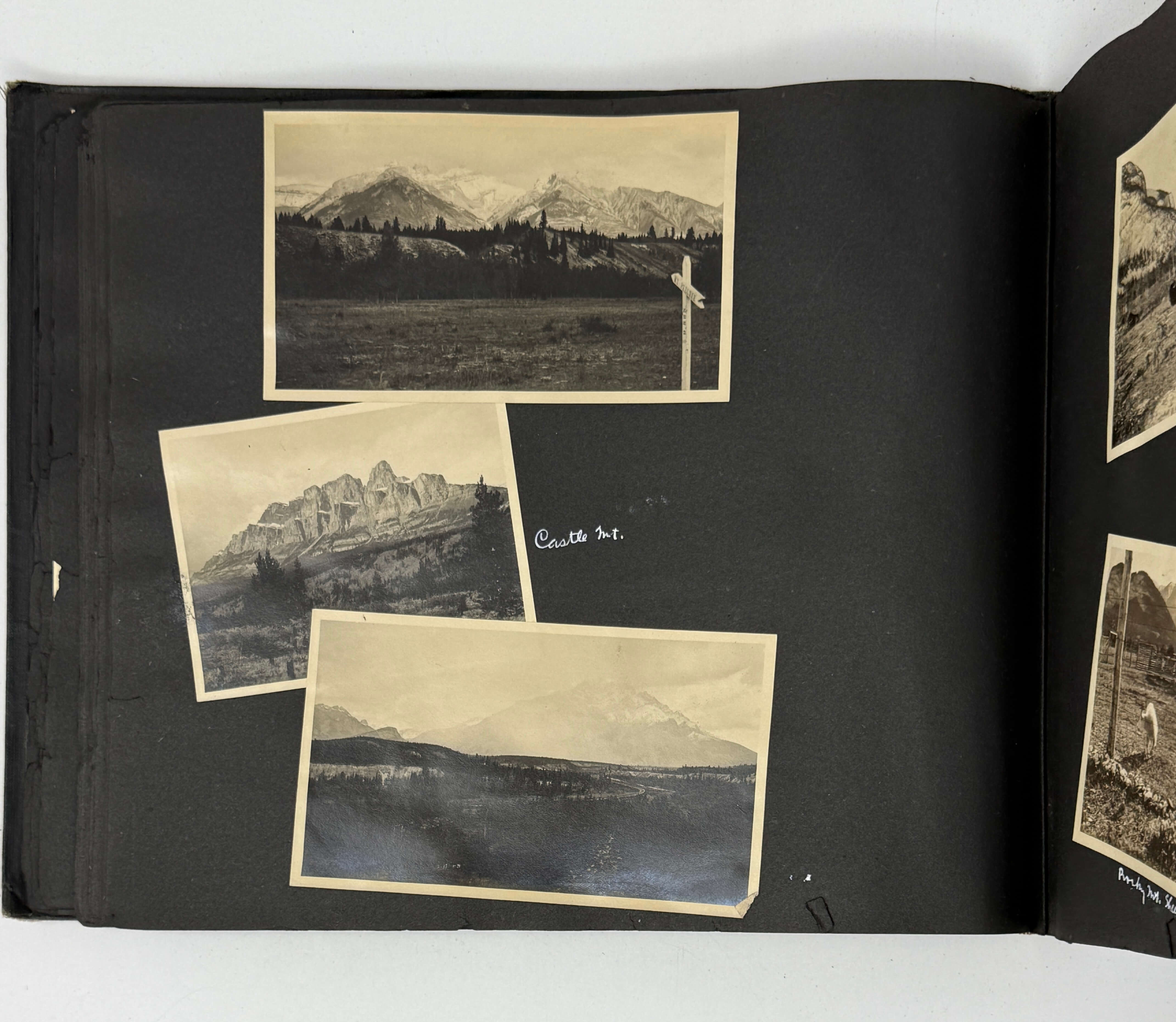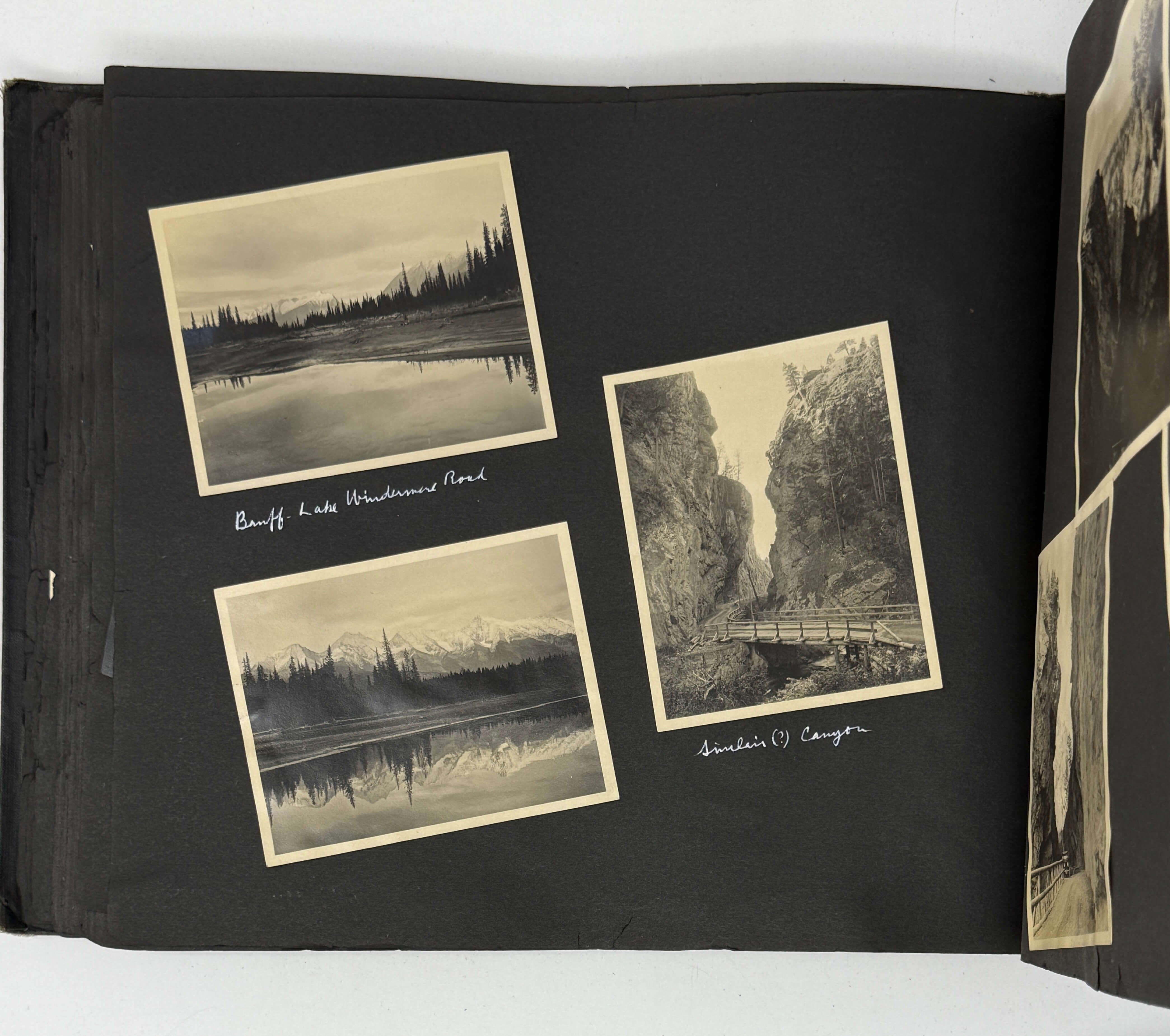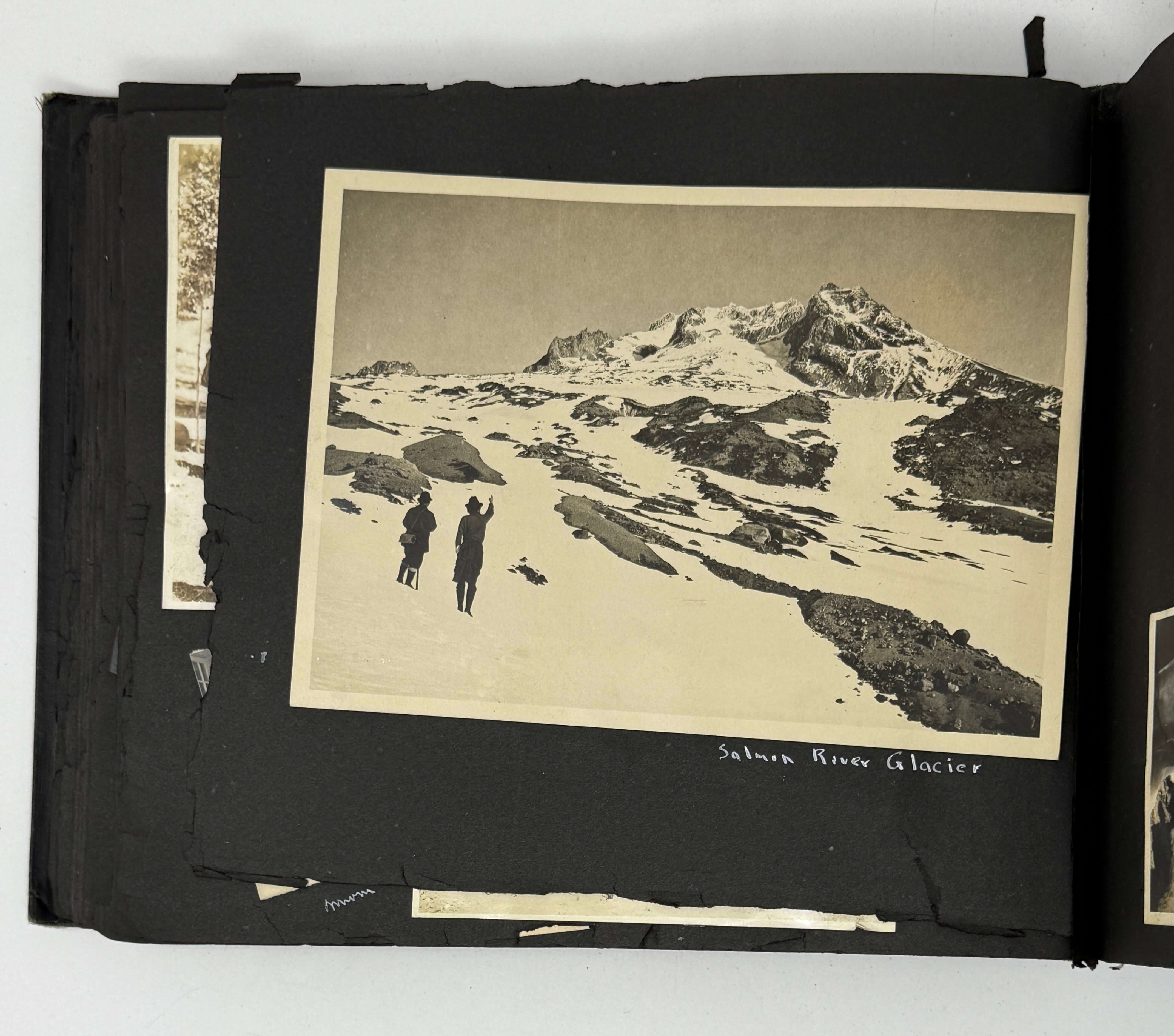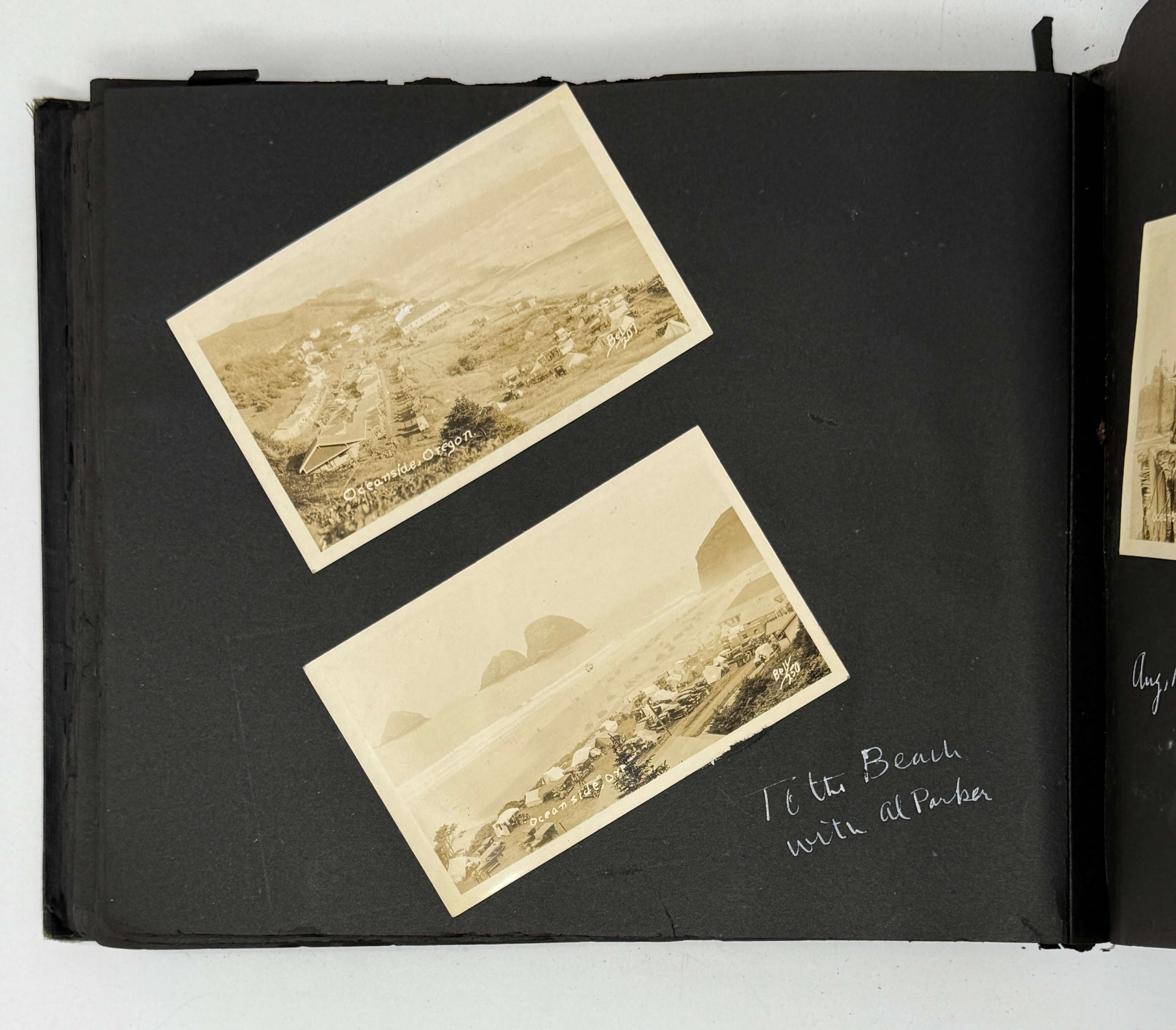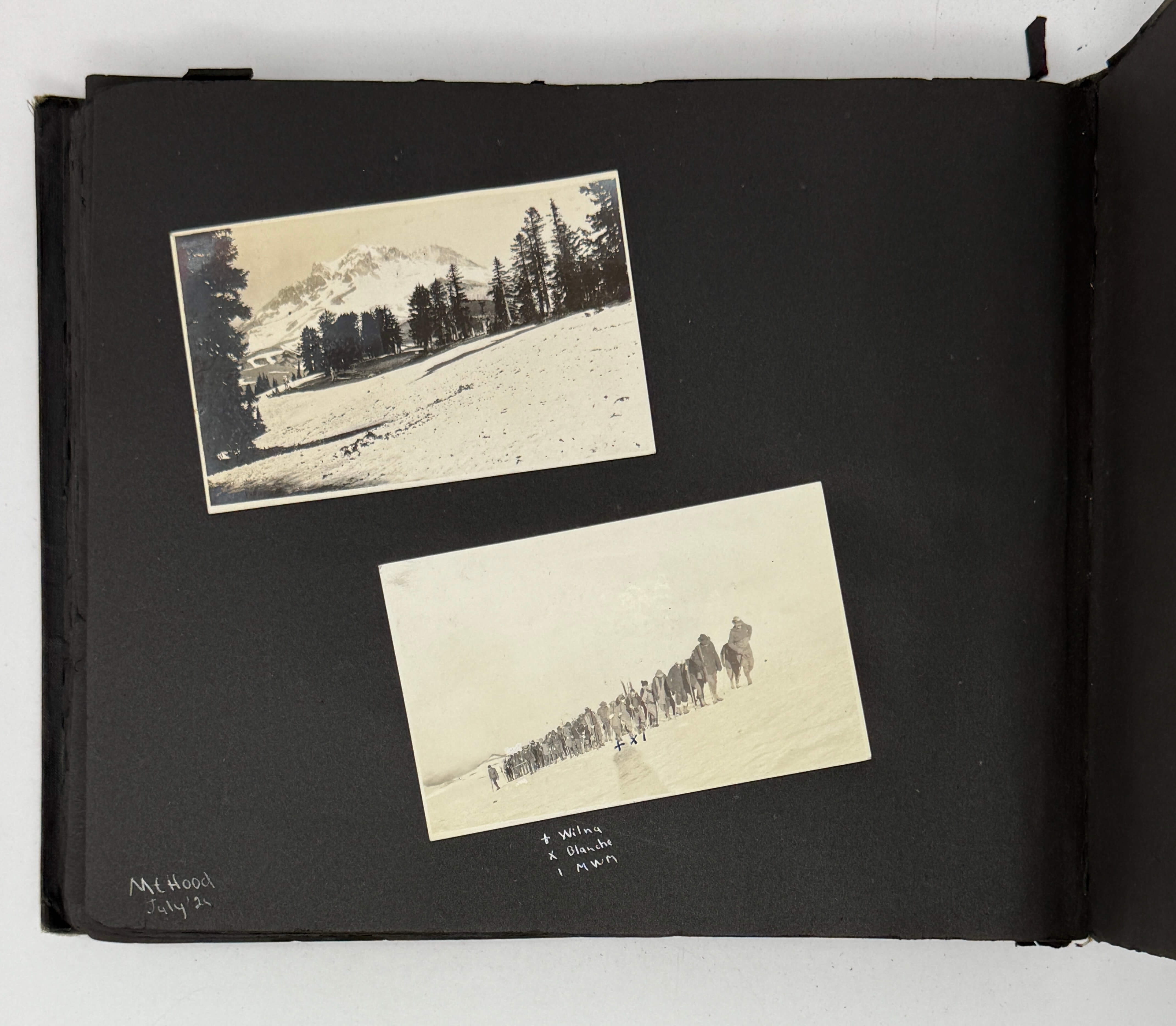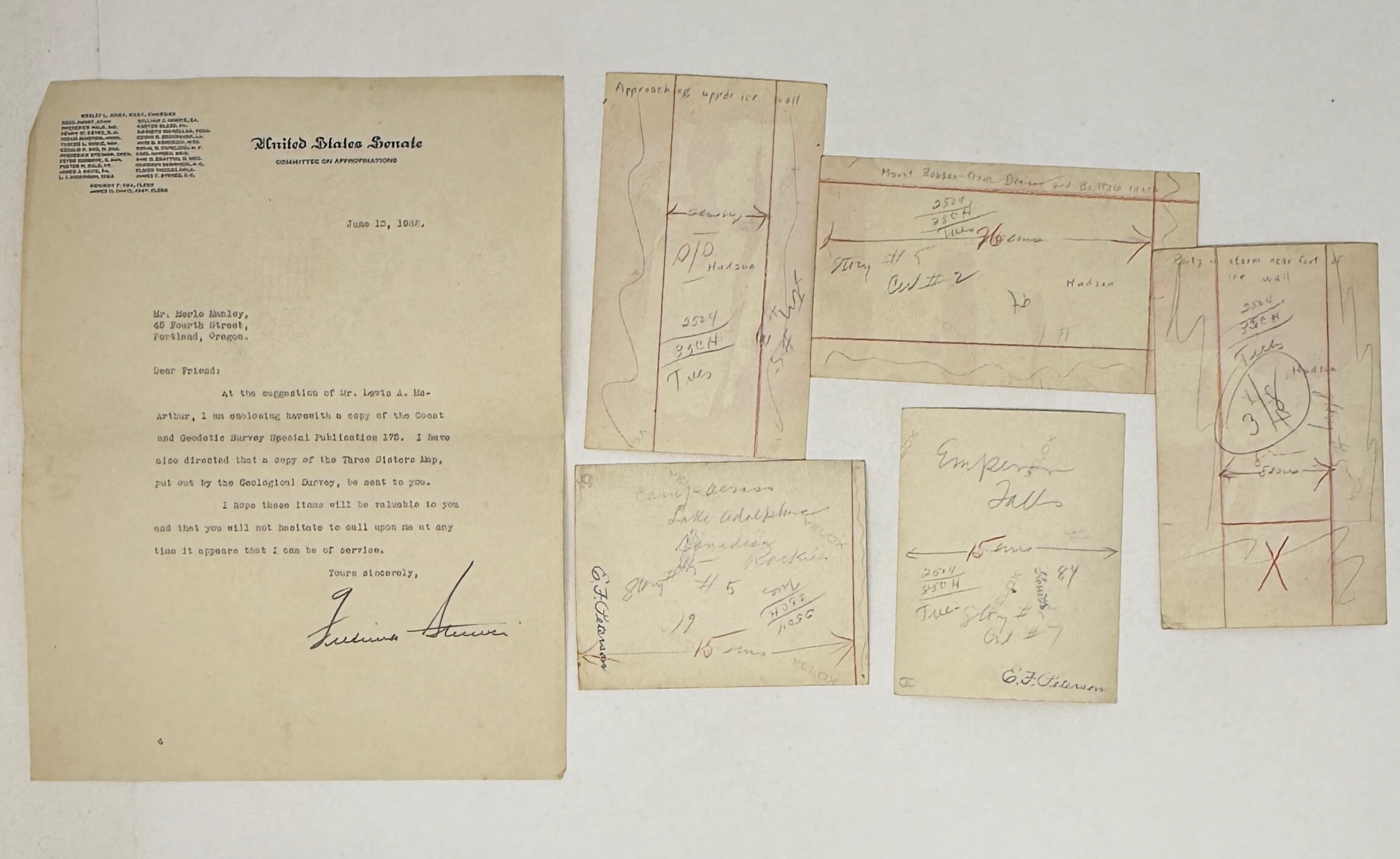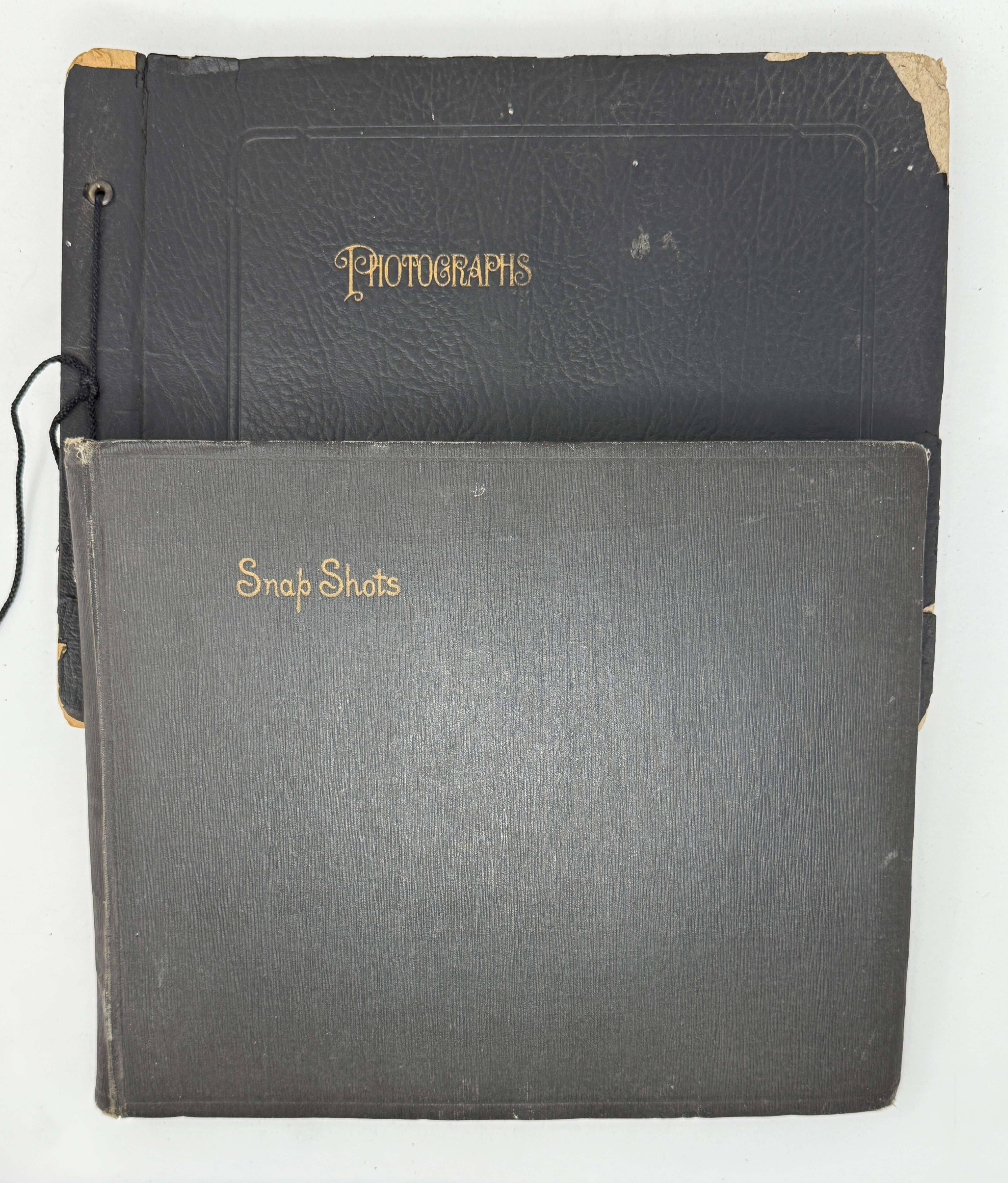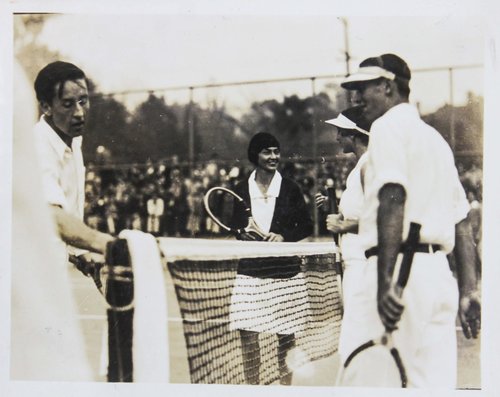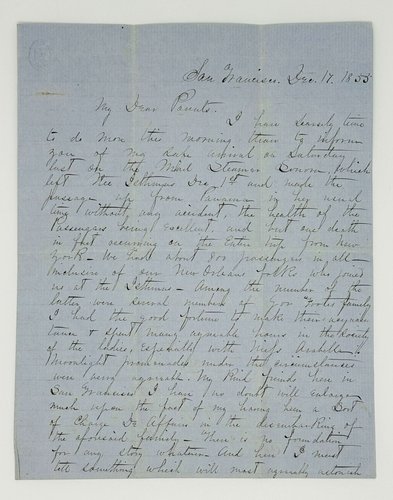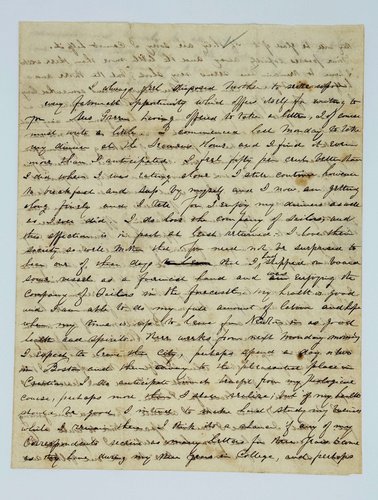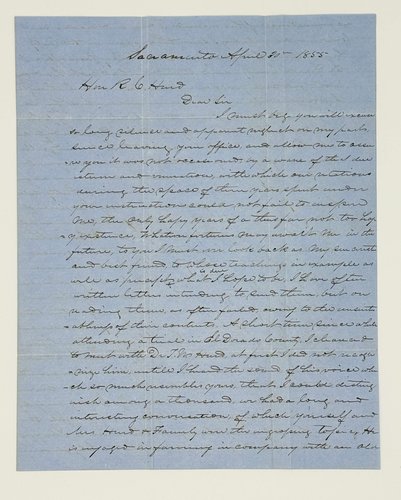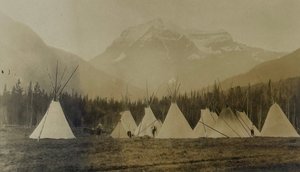
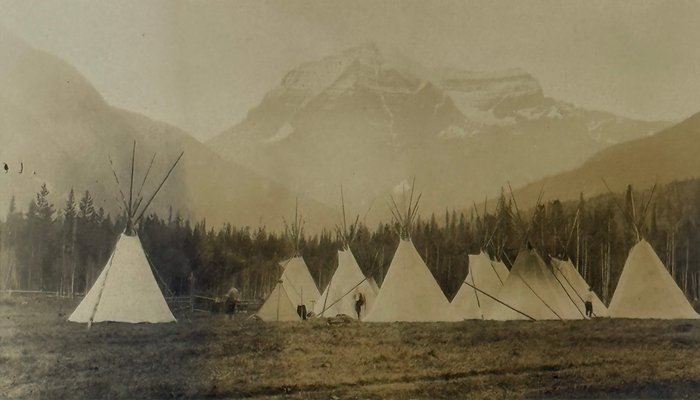
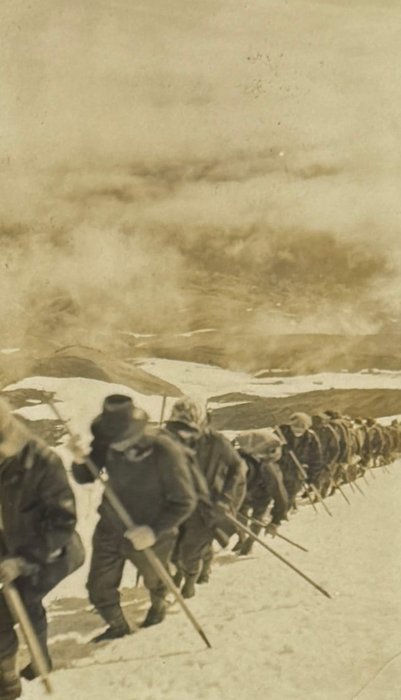
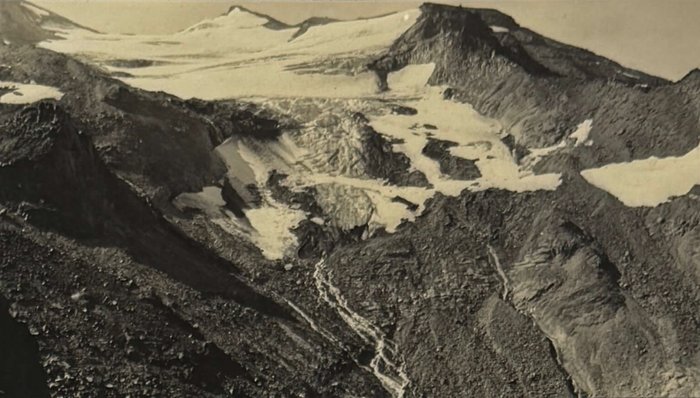
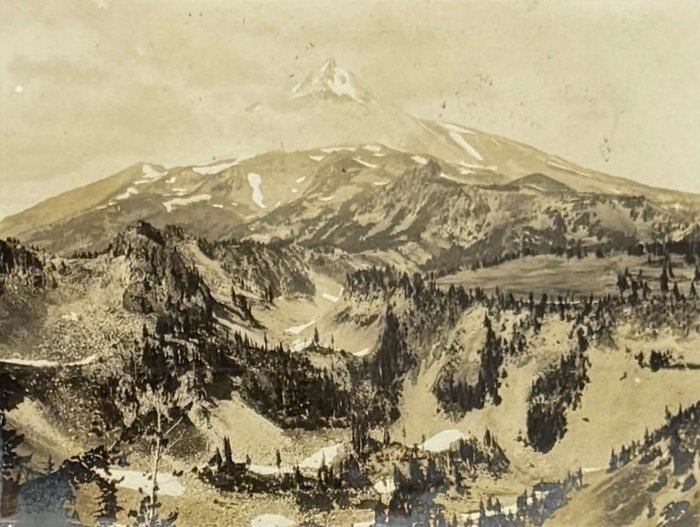
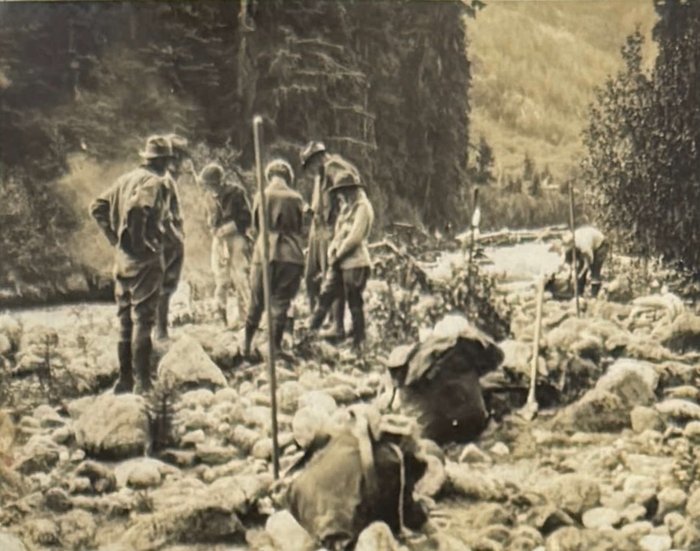
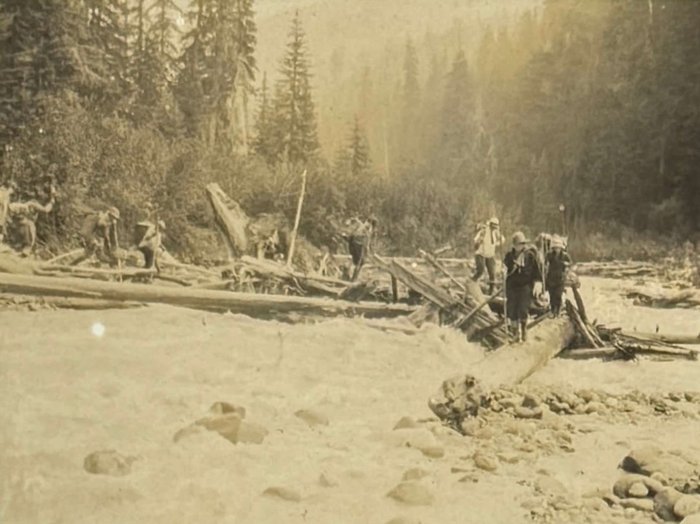

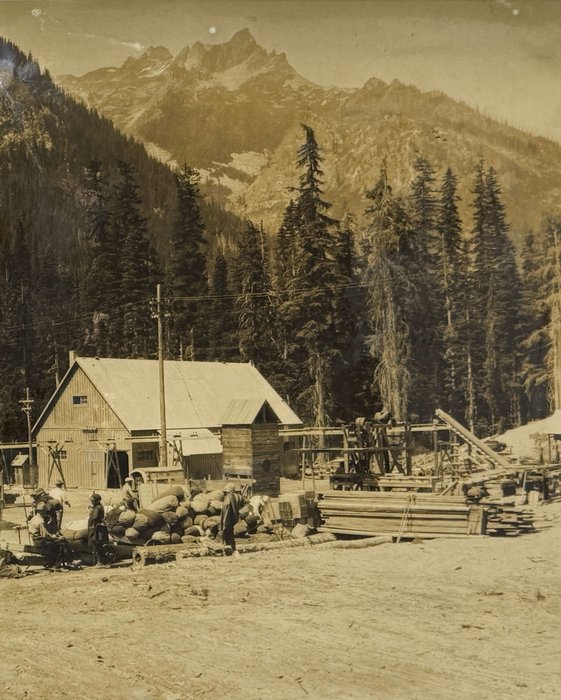
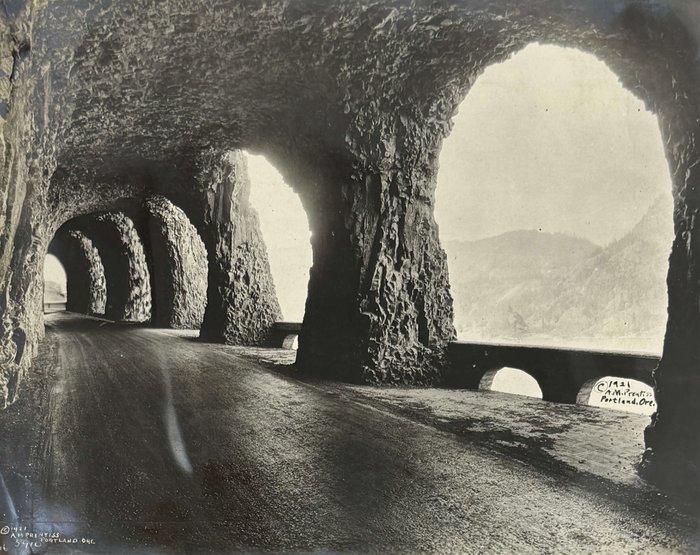
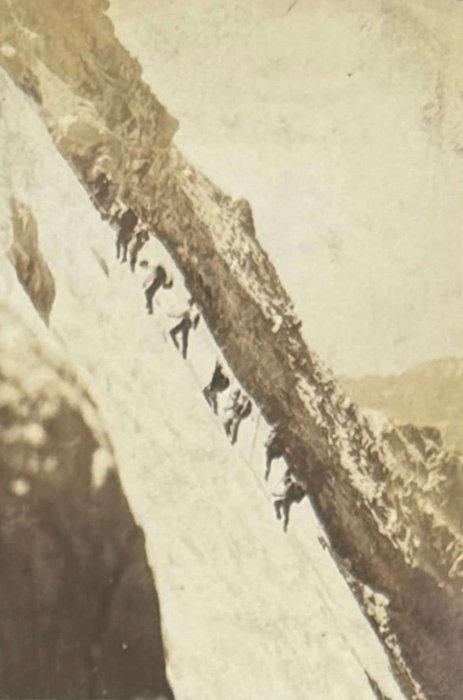
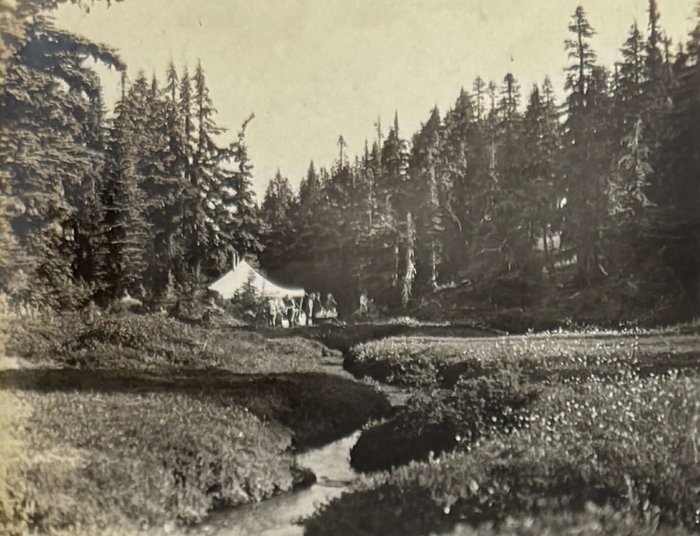
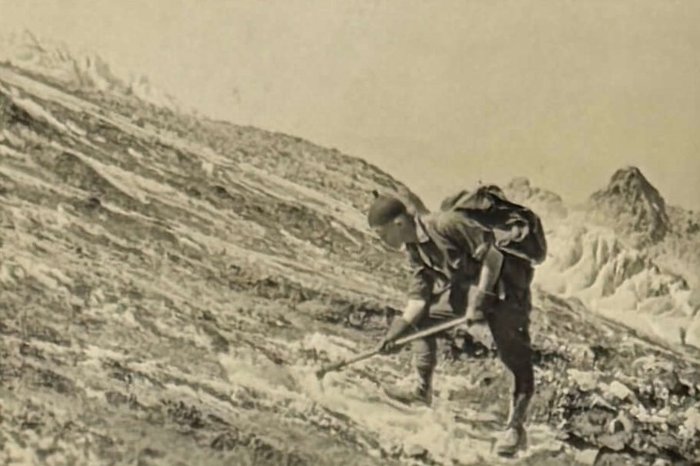
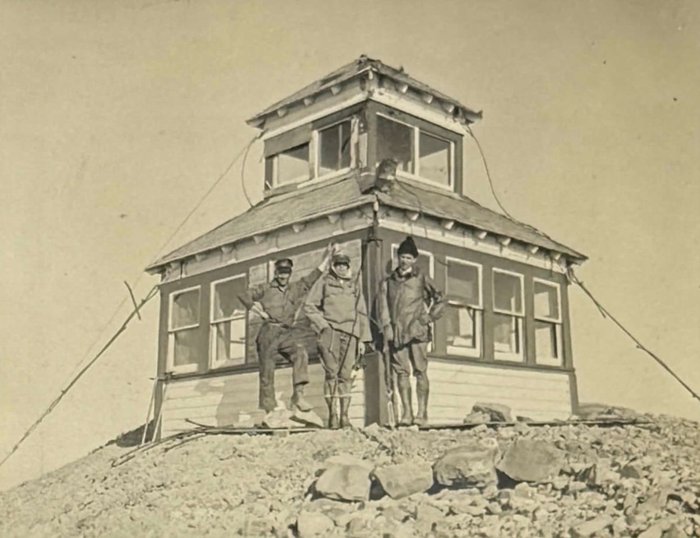
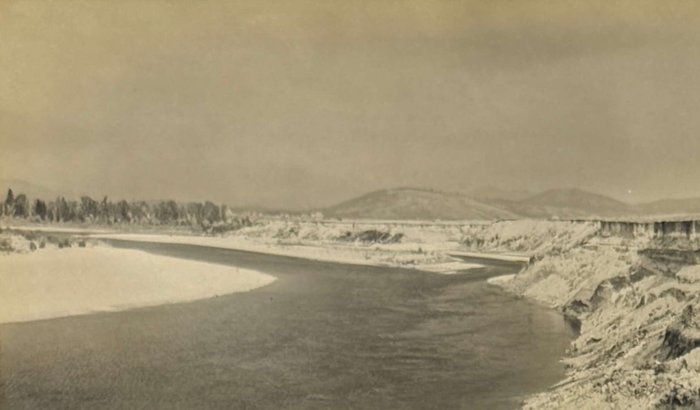
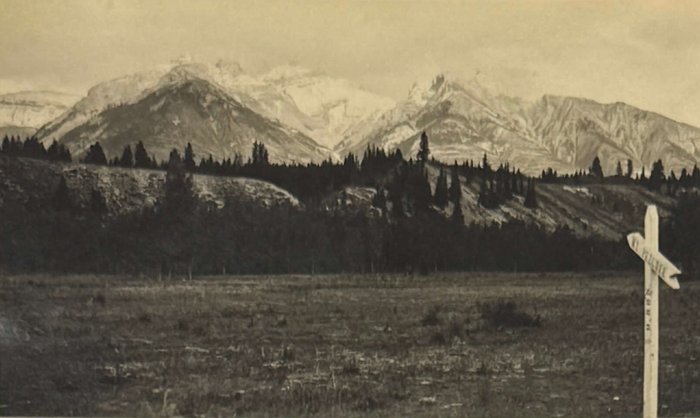
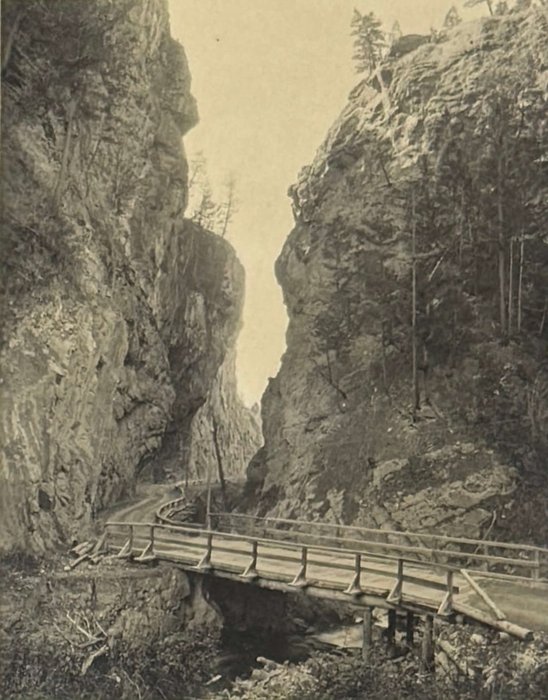

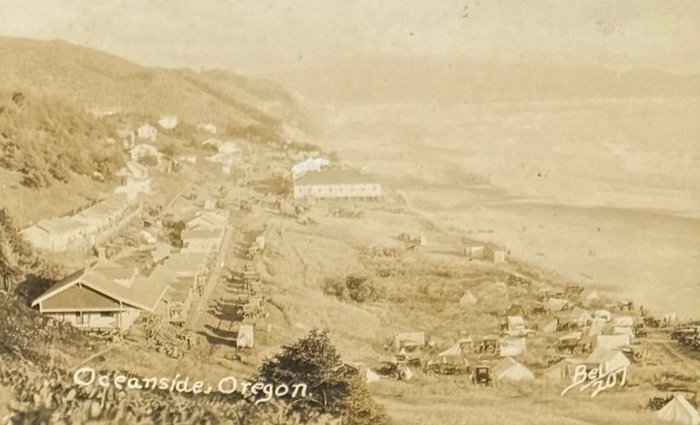
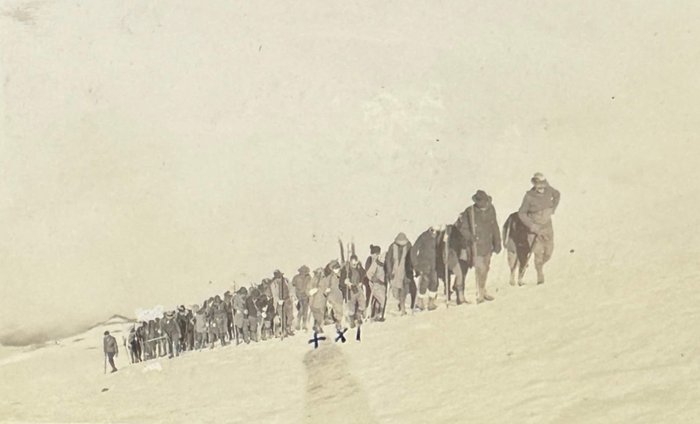
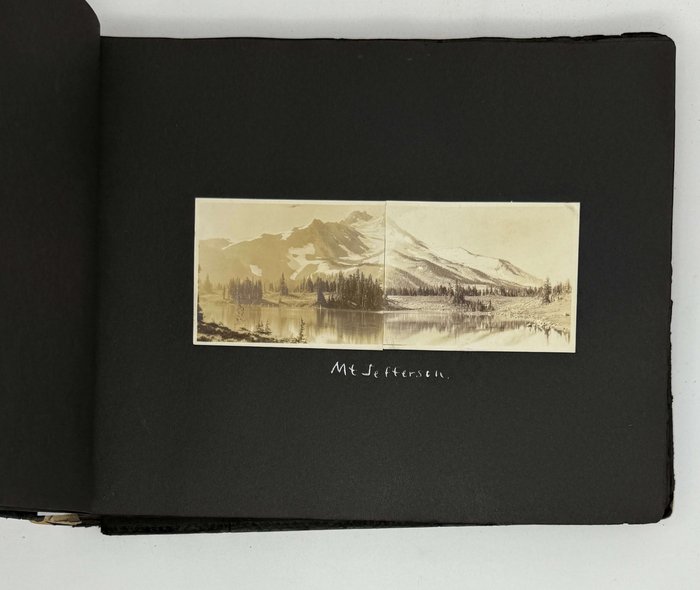
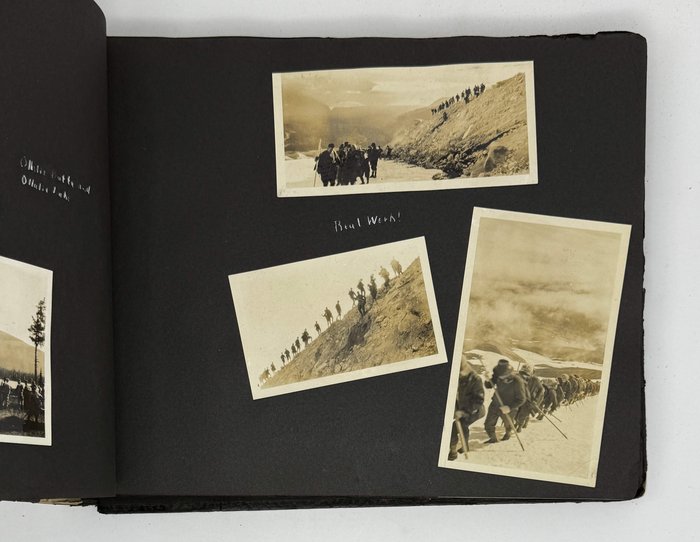
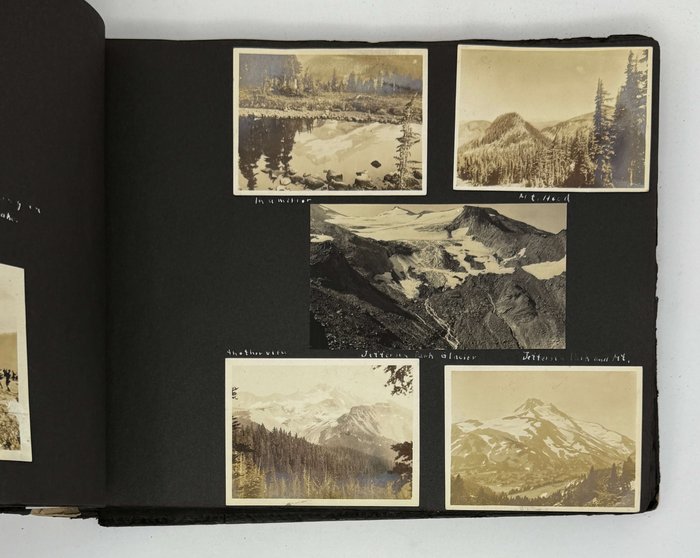
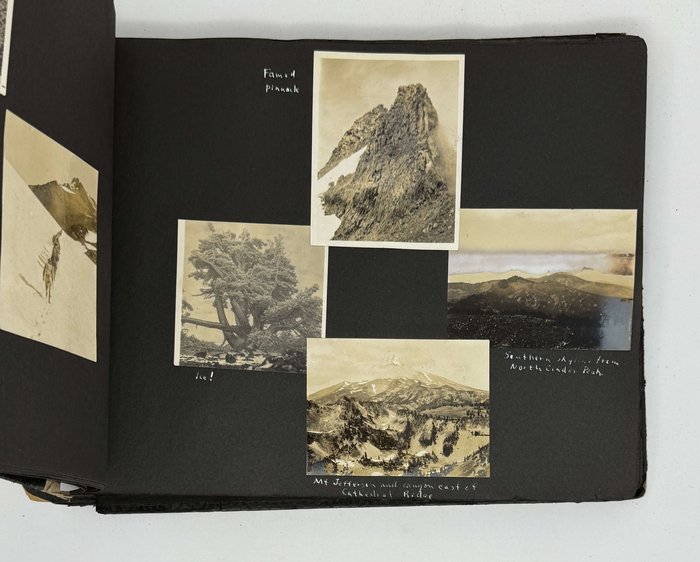
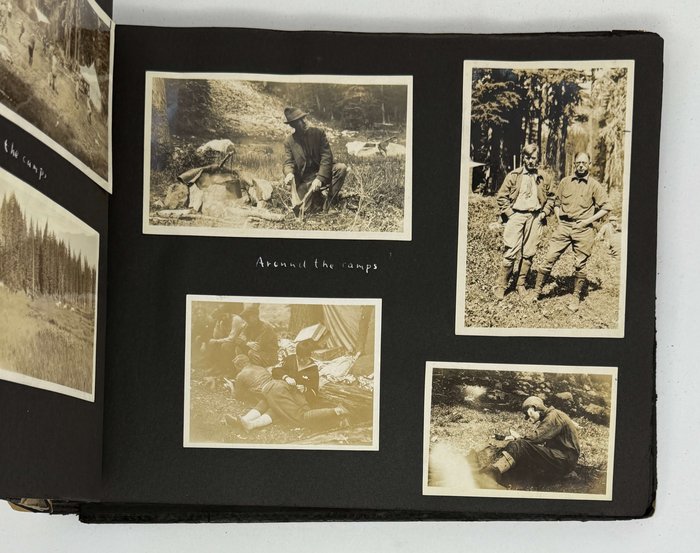
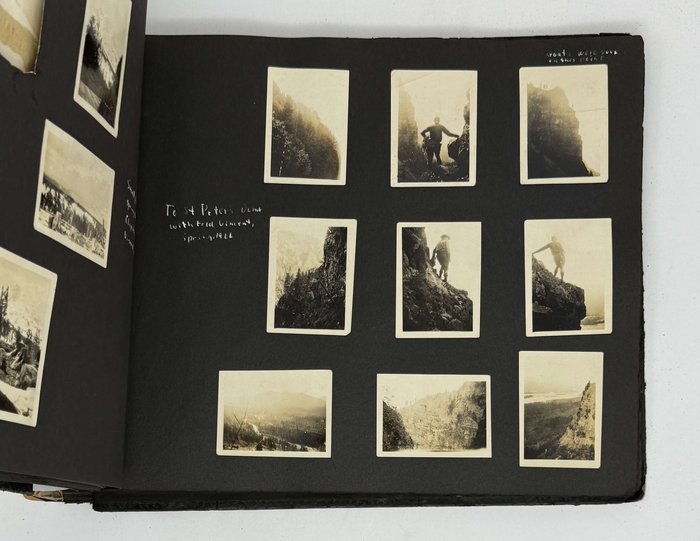
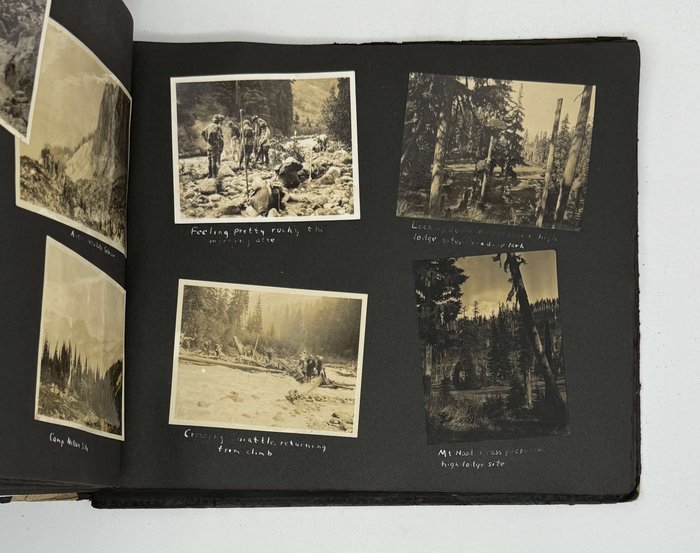
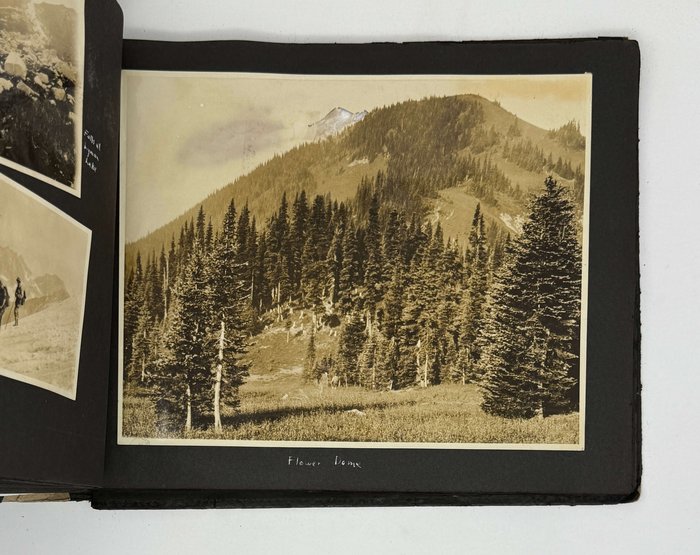
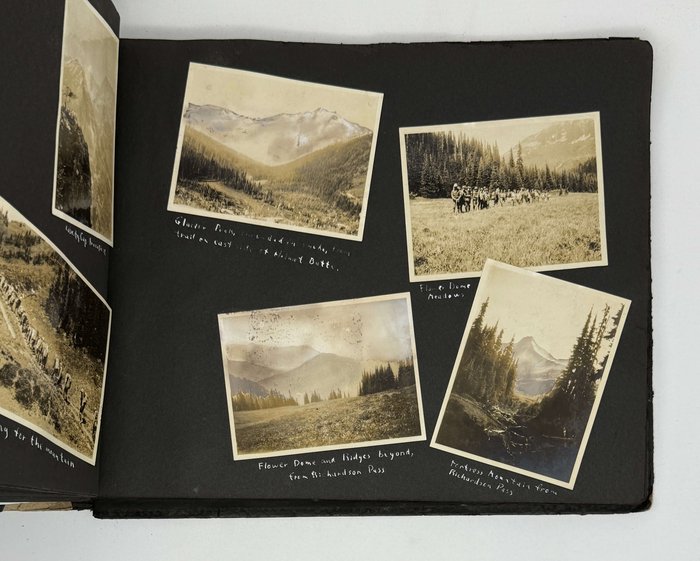

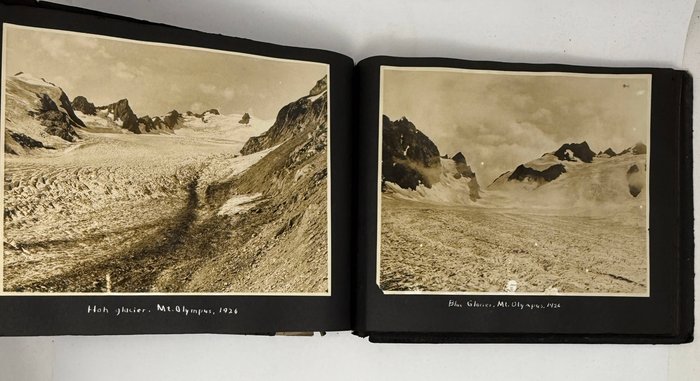
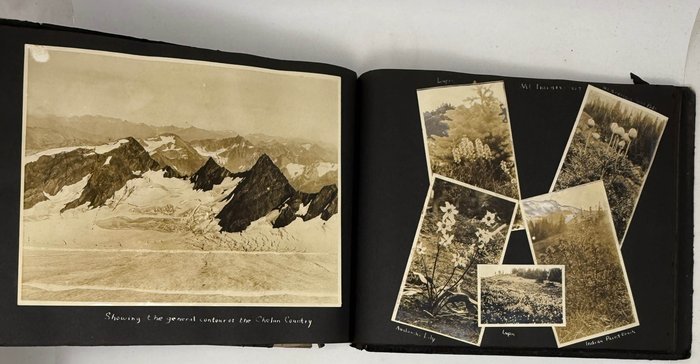
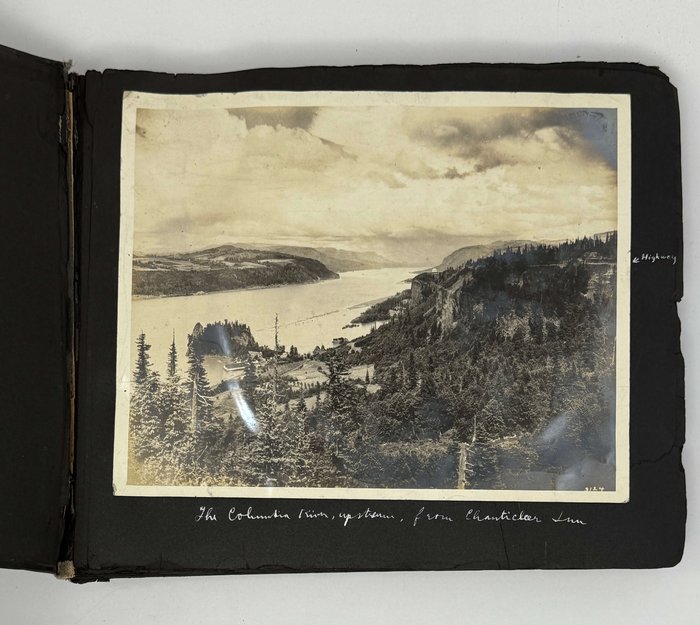
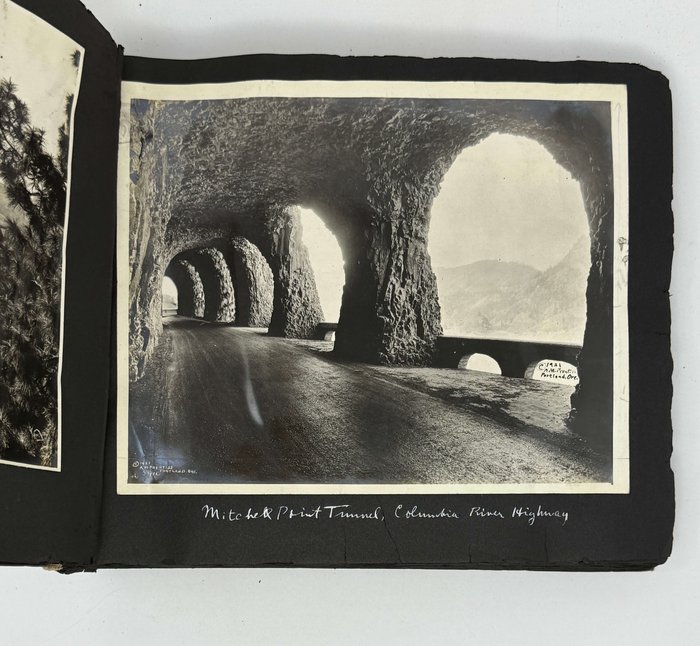

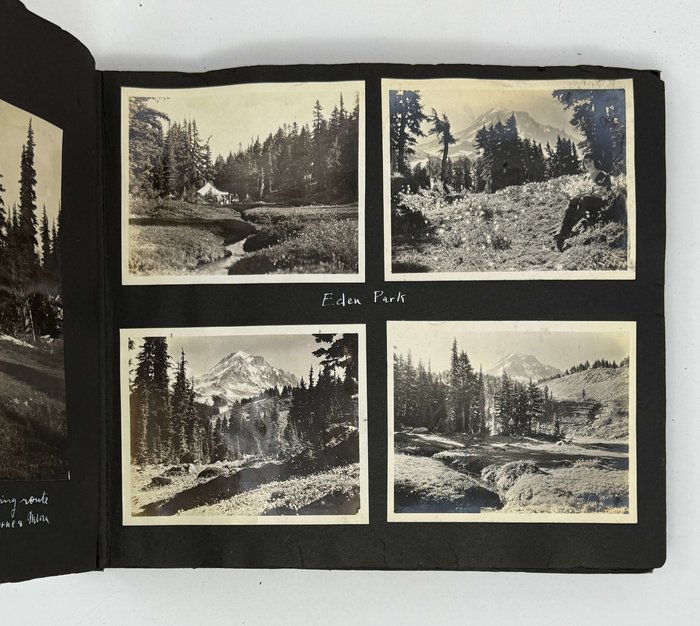
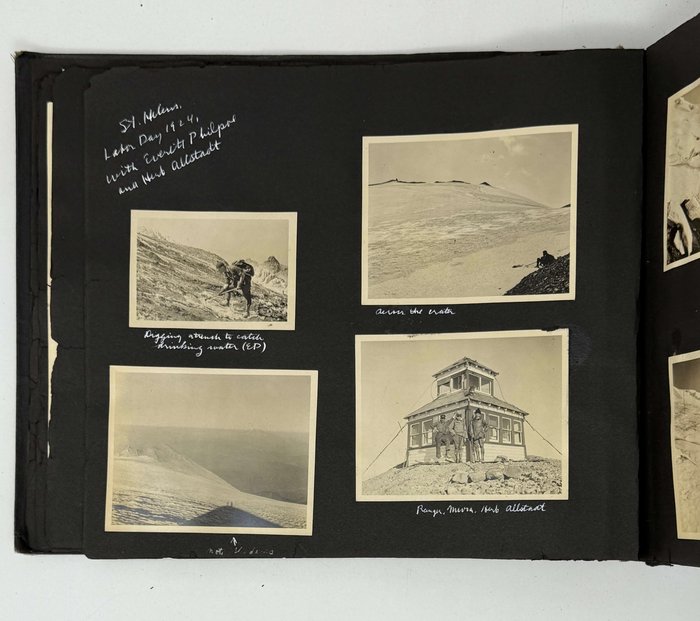
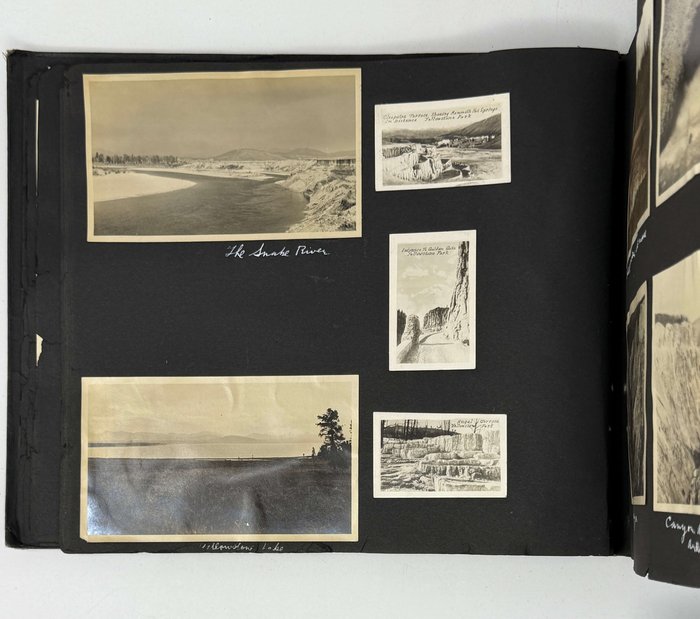

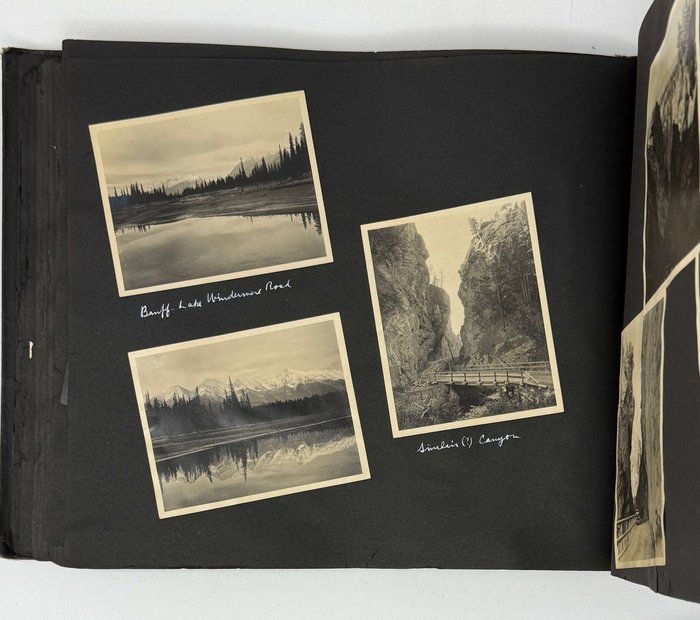
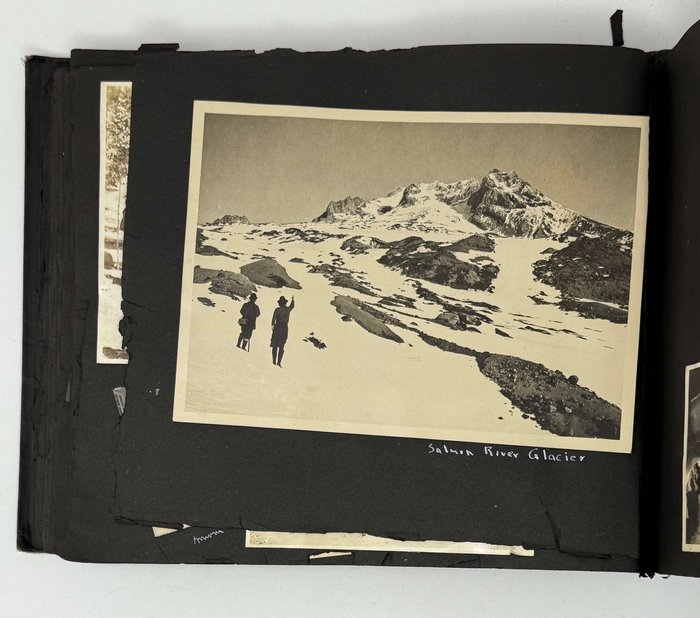
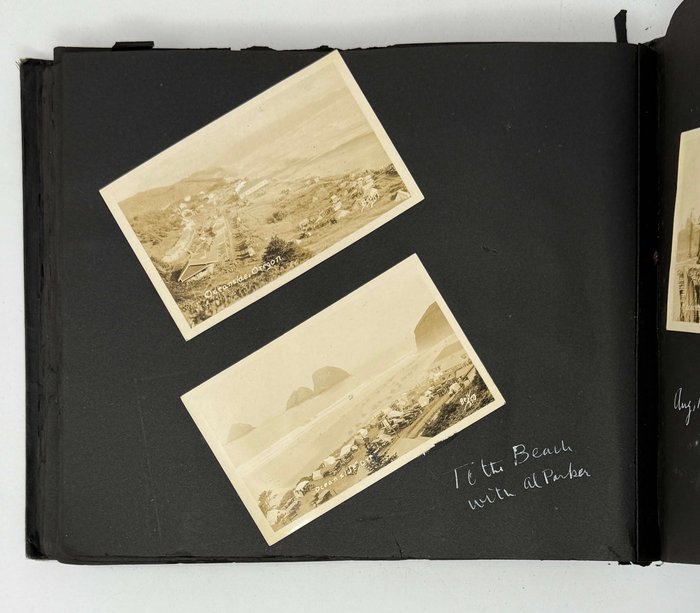
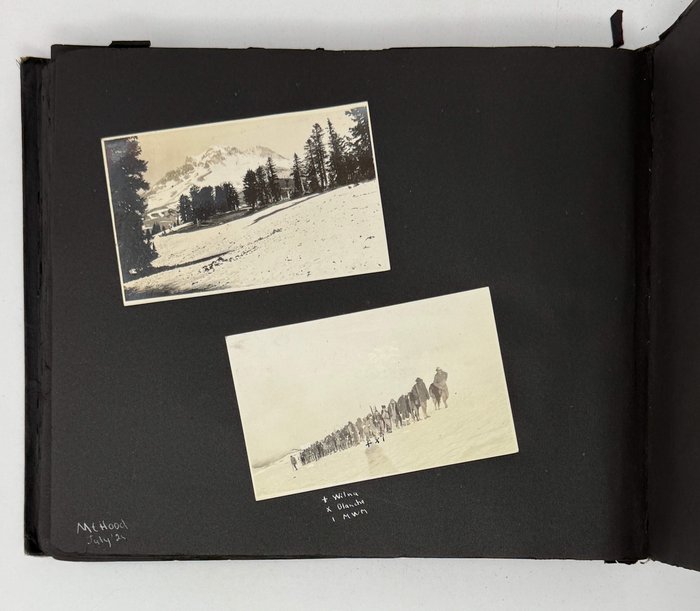
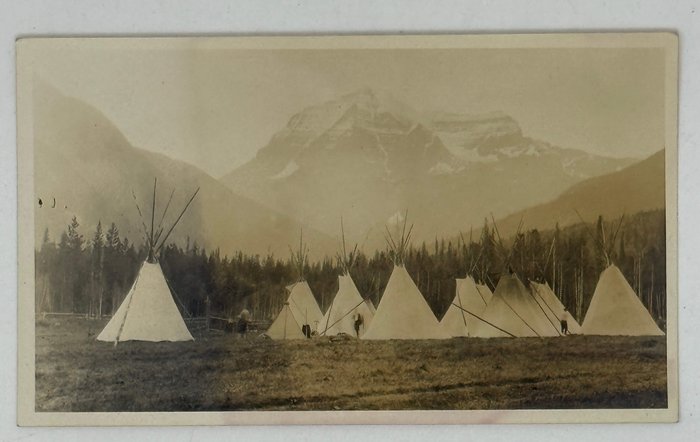
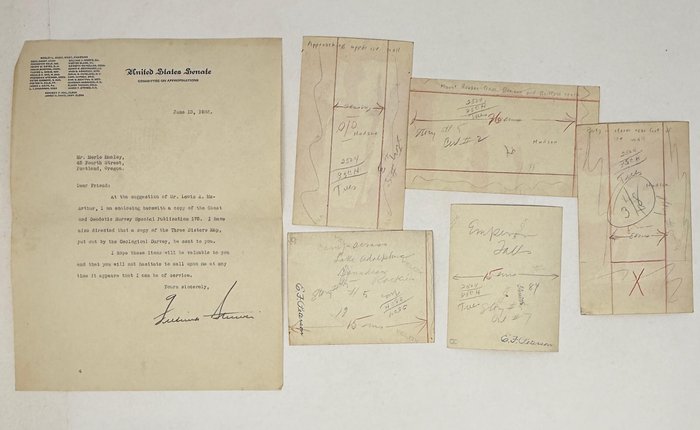
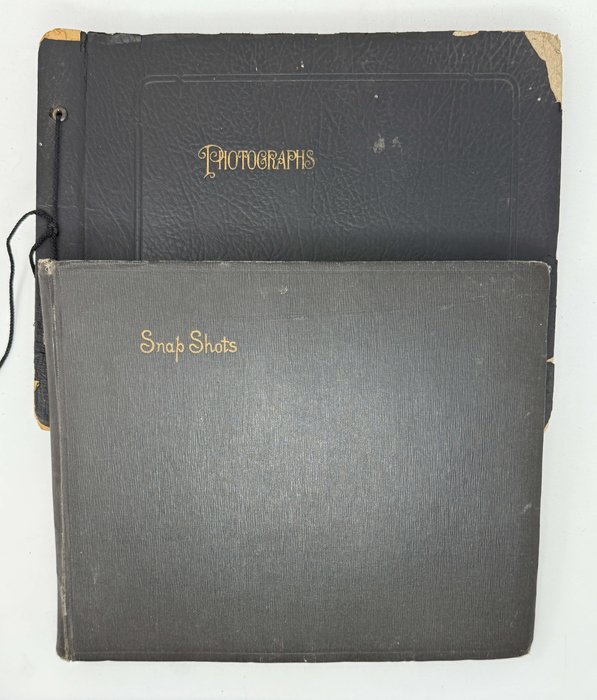
#PE65ab
Ca. 1923-1927
Two Oblong Folio albums, from ca. 26,5x34 cm (10 ½ x 13 ¼ in) to ca. 26x31 cm (10 ¼ x 12 in). 48 (12 blank) and 50 (2 blank) black stock leaves. Both albums with over 480 mounted original gelatin silver photos, including four panoramas from ca. 8,5x36 cm (3 ¼ x 14 ¼ in) to ca. 7,5x20 cm (3 x 7 ¾ in) and over thirty large images from ca. 21x26 cm (8 ¼ x 10 ¼ in) to ca. 12x17 cm (4 ¾ x 6 ¾ in); the rest of the photos are from ca. 8,5x14 cm (3 ¼ x 5 ½ in) to ca. 4,5x7 cm (1 ¾ x 2 ½ in). Most photos with period white ink captions on the mounts (many captions relate to several images); several series of images are dated from 1923 to 1926; several photos with the routes of mountain ascents outlined in pencil or ink by the compiler. With a printed illustrated brochure “A trip through Land of Wool,” authored by Manly (Oregon City Woolen Mills, 1924, 24 pp.), inserted into the mounted printed envelope of the “Oregon City Woolen Mills.” With a mounted silk ribbon, commemorating Mazamas Club’s ascent of Mt. Hood in July 1925 and a mounted paper ribbon advertising the dedication of new Mazamas Club rooms in Portland, Oregon, in May 1926. With 17 loosely inserted gelatin silver photos from ca. 13x16,5 cm (5 ¼ x 6 ½ in) to ca. 7x8,5 cm (2 ¾ x 3 ¼ in); seven images with period pencil captions on verso; two photos with ink stamps “E.F. Peterson” on verso. With a loosely inserted typewritten letter to Manley from the “U.S. Senate, Committee on Appropriations”, ca. 20x26,5 cm (8 x 10 ¼ in), signed by the Oregon committee member Frederick Steiwer.
Period black faux leather album, fastened with a string, gilt-lettered title “Photographs” on the front cover; period black full cloth album, gilt-lettered title “Snap Shots” on the front cover. Bindings rubbed on extremities; one with the rear cover detached from the stub; the other with the binding detached from the stub. Mounts brittle, with tears and chipping on extremities, several leaves detached from the stub and loosely inserted, one photo with the top upper part cut out, several images heightened in white, a few photos with mild fading, but overall a very good collection of strong interesting photos.
Historically significant, extensive collection of ca. 500 original gelatin silver photos, taken and collected by an Oregon mountaineer, writer and advertising agent, Merle W. Manly. In the 1920s, he was a member of the “Mazamas” alpine club, founded in Portland in 1894 (the third oldest in the United States after the Appalachian Mountain Club, 1876 and Sierra Club, 1892; see more). During this time, Manly was a member of the Mazama Executive Council (1926-1932, with breaks) and several committees, its vice-president (1928), official historian (1931-1932) and the editor (1924-1928) of the club’s annual publication “Mazama: A record of mountaineering in the Pacific Northwest.” The “Mazama” published three of Manly’s illustrated reports of the club’s mountaineering expeditions: “The West side climb of Mt. Hood in 1923” (1923, p. 21), “The Conquest of Mt. Logan” (1925, p. 85) and “Next year, Mt. Rainier” (1926, p. 106). Manly published at least two works in a book form: an advertising brochure “A trip through the land of wool…” (Oregon City Woolen Mills, 1924), present in this collection; and an illustrated account of a winter ascent of Mount Hood “When winter comes” (Portland, Or., 1933). In his main time, Manly worked in the Portland advertising industry and in the 1940s was the chairman of the Oregon branch of the American Association of Advertising Agencies (The Oregonian, 15 October 1947, p. 17).
The two albums date back to Manly’s active mountaineering years with the “Mazamas” and document at least fourteen of the club’s expeditions in the Cascades in the 1920s. One of the earliest is “Mazama Outing, Mt. Hood, 1923,” with over 20 images, including various views of Paradise Park, Eden Park, Barrett Spur, “Ice falls of Reid Glacier,” two excellent large views of the Reid Glacier (one outlining the Mazamas party’s route), a large view of “Mt. Hood from Eden Park, showing route of West Side Climb made by Bob Osborne & M[erle]. W.M[anly].,” several views of the party camp, “my tent <…> hidden by the trees,” a scene with climbers going up the snow slope – “M.W.M. 2nd from bottom,” &c.
Very interesting are the photos of Manly’s climb on “St. Helens, Labor Day 1924 with Everett Philpoe and Herb Allstadt.” Eighteen photos include views “across the crater,” of St. Helens’ high slopes, glaciers and crevasses, a portrait of “Ranger, M.W.M., Herb Allstadt” posing in front of the cupola cabin on Mt. St. Helens lookout site, “Harmony Falls, Spirit Lake,” “Gold mine camp on shore of Spirit Lake,” the shores of Spirit Lake and St. Helens’ silhouette, which changed irreversibly after the May 1980 eruption. Two other photos, dated “1/4/25” show Spirit Lake and a group of hikers posing on shore.
Over eighty photos from the series “Mount Jefferson, 1925” include views of mountain scenery, the climbers ascending in a line, reaching the summit, camping; slopes, high altitude terrain and crevasses of Mt. Jefferson, &c. Six additional images from the group, titled “North Side climb, Mt. Jefferson, 1925” include “north-west view of Mt. Jefferson from West Butte, showing route of ascent crossing base of high glacial cirque topped by 400 ft. spire,” “south horn of main pinnacle, Jefferson,” “Prehistoric Monster,” “main pinnacle of Mt. Jefferson from saddle directly to the north; climbers scaled this peak by skirting its base to the right and climbing up a chimney on its west face” (with a track outlined in white); and a view “taken from summit of Mt. Jefferson, looking to the north and showing route of ascent after passing “Prehistoric Monster,” cross shows spot where picture of main pinnacle on preceding page was taken.”
A group of five photos, titled “Research Committee Work, 1925” shows “lines run to measure movement of Elliot Glacier, 1925, line I for glacier proper and Line II for terminus;” a photo of a climber (likely, the compiler) with a survey instrument, captioned “showing how one end of Line I moved from 7/13/25 to 9/13/25,” and a “type of marker developed by Charley Wilson in 1926.” Two photos document “<…> how glacier moved down and broke up during 2 months.”
Over 40 photos from the series “In the Glacier Peak region, 1926” include views of the Glacier Peak and surrounding scenery (Chocolate Glacier, Flower Dome, Fortress Mountain, “cirque on Granite Mt.,” Buck Mountain, Lyman Lake and camp, Lyman Glacier), “Trinity Mines Camp,” the Mazamas party in cars leaving Leavenworth, “starting for the mountain,” walking through the “Flower Dome meadows,” “going across the Chocolate Glacier, “cooling off in the couloir,” “feeling pretty rocky the morning after,” “crossing Suiattle, returning from climb,” getting on boats on Lake Chelan on the way back, posing in front of train cars in Chelan Falls &c.
Over thirty images from the series “Mount Rainier, 1927” show alpine flowers, “Rainier and Little Tacoma,” “Shadow Lake Camp,” “Avalanche Camp,” “baseball at Shadow Lake,” “Old Desolate,” “1st day climb – crossing Winthrop,” “Mystic Lake and lower end of Winthrop Glacier…,” “coming up the Carbon Glacier Trail,” “Rainier from Sourdough Range,” “N.E. view of Rainier from Mt. Fremont,” “Seracs, Winthrop Glacier,” “North side of Rainier showing Willis Wall and Carbon Glacier from Old Desolate,” “Party on Mineral Mountain, Old Desolate in background,” “leaving the rangers for Olsen’s cabin,” &c.
The other series of photos document the following Mazama expeditions: “Mazama Outing, Mt. Adams, 1924” (36 photos, including views of Adams glacier, a group portraits of the hiking party on the summit and a series of images documenting the ascent on the west side); “A ski trip from the Lodge, 1923;” “Decoration Day, 1925;” the ascent of the Grand Teton Range (including a group portrait of the mountaineers on the summit); the ascent of Mt. Hood from Paradise Park in July 1925 (including photos of the climbing party on the mountain and the commemorative silk ribbon); “Small pictures on spring trip to Cloud Clap Inn with Fred Wincent, 1926;” “To St. Peter’s Dome with Fred Vincent, spring 1926;” and a hike to Mt. Chinidere on “Decoration Day, 1926” (Tunnel Falls, Eagle Creek, views of Mt. Hood from Mount Chinidere, Wahtum Lake)
Over 100 photos from the series “Motor Trip to Canada with the Philpoes, 9/12/24 – 9/30/24, 3133 miles” include views of the Teton Range (Wyoming), Yellowstone Park (Yellowstone Lake, Grand Canyon, Old Faithful, Mammoth Hot Springs, Liberty Cap), Glacier National Park (Montana), Banff National Park (Castle Mountain, Banff, Lake Louise), Marble Canyon (B.C.), two panoramas (“On the Banff – Lake Windermere Road” and “Where the Columbia River begins”), Columbia Lake, Lake Windermere, &c.
The collection also includes four photos of “a proposed high lodge site, Paradise Park” near Mount Hood, three views of “Mazama Lodge,” and two images of the interior of the “Main Room” and “Council Room” in the Mazamas Club headquarters in Portland. Mounted paper ribbon invites to the “dedication of new club rooms, Roof Floor, Pacific Building, Portland, Oregon; May 7th and 8th, 1926.”
Other interesting photos include large studio views of Columbia River, Mount Hood and “Mitchell Point Tunnel, Columbia River Highway,” excellent images of glaciers on Mt. Olympus (dated 1926), scenes with mountaineers on the Salmon River Glacier, a group “leaving Paradise Park for Eden Park, Mazama Outing, 1923,” three large views of an icy mountain slope, &c.
The collection also includes 17 loosely inserted photos, with views of “Mt. Robson from Denison and Brittain ranch,” “Camp across Lake Adolphus, Canadian Rockies,” “Rainier from Mystic Lake Camp,” “Party in storm near foor of ice wall,” “Approaching upper ice wall,” &c. The enclosed typewritten letter to “Mr. Merle Manley” has a printed letterhead of the U.S. Senate Committee on Appropriations and is signed by its member from Oregon, Frederick Steiwer.
Overall, an important, content-rich visual source on the history of the “Mazamas’” mountaineering in the Cascades in the 1920s.

